Synology DSM 7 vs TrueNAS Core – Software Comparison
Choosing between these two incredibly popular platforms for secure storage, accessing and sharing your data is not easy! With Synology and DSM, you have a premium hardware+software platform that easily emulates entire operating system levels of features, with an incredibly user-friendly design, initiative controls and a wide range of included applications and services with their own mobile applications. In TrueNAS you have an open-source and largely free to download service that allows you to create a detailed and completely customizable storage system, built on one of the most popular file systems in the storage community, a wide degree of 3rd party support and ease of integration thanks to the hardware being DIY and widely customizable. Both NAS software platforms are used by home and business users alike, but with one of them being paid and the other being free, there are plenty of arguments as to why one NAS software might be better suited to your needs than the other. So today I want to compare Synology DSM 7 and TrueNAS Core, breakdown each of their individual pros and cons, how they differ and ultimately help you decide if you should choose TrueNAS or Synology for your own private server. Let’s begin.
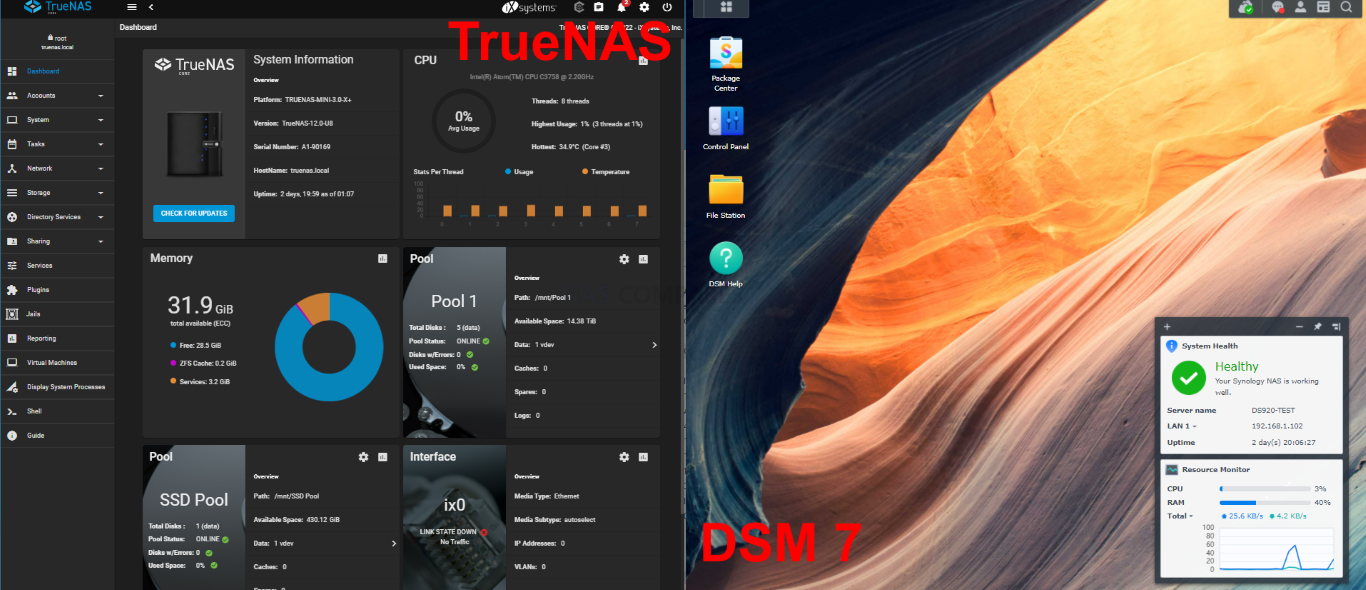
Synology DSM 7 vs TrueNAS Core – Quick Conclusion

It is so easy to just look at the TrueNAS option as the free but complex choice and the Synology DSM option as the easy but expensive one, BUT the truth is a little more complex than that. For a start, the wide variety of customization and flexibility that is inherent to TrueNAS is something that I genuinely think only higher-end business users are going to be able to fully realise. Home users who are building their own NAS from scratch and opt for TrueNAS for the software will definitely enjoy customizing their solution to their needs/network-environment, but the most long term customizations, reports and adaptive protocols of TrueNAS are much better suited to a business that needs to change as business/staff/data grows. Ironically though, those users are going to be far more attracted to a ‘turnkey’ solution (i.e a NAS solution that is pretty much good to go, right out the box) and will pay for the privilege (i.e time is money). This is where Synology steps in quite confidently, as they know they are incredibly business appealing, with a massive range of first-party apps to migrate away from Google/Microsoft services, as well as management and security tools that are largely unparallel elsewhere in the industry. TrueNAS is still a viable option for businesses that desire an instantly deployable solution and business class support with the official TrueNAS hardware provider iXsystems providing pre-populated and customizable solutions, as well as tiered support subscriptions – but this only truly appeals to users who truly understand what FreeBSD and ZFS can provide that EXT4 and BTRFS cannot.
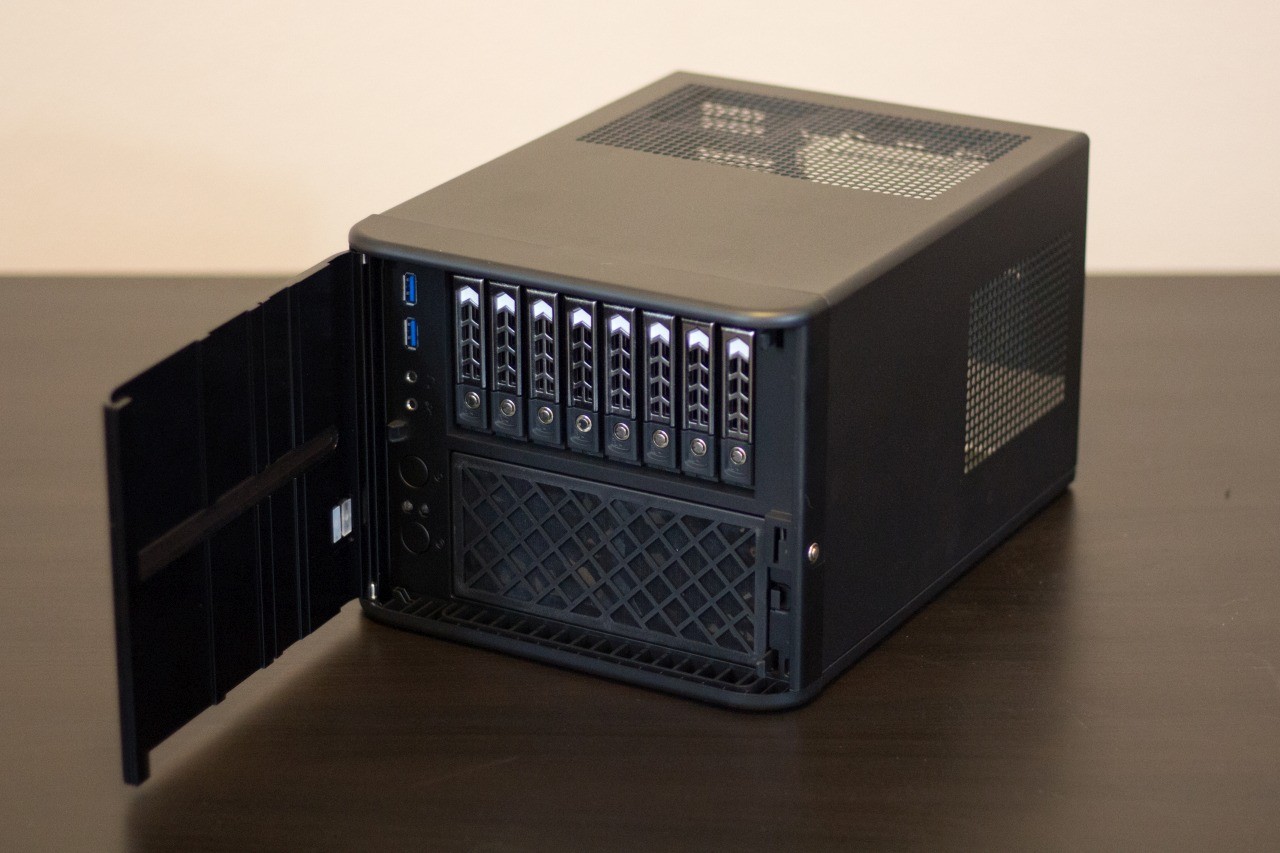
The Synology DSM platform is incredibly impressive and available in systems (as in included with the hardware as a single purchase) for as little as £120 (such as the DS120j) and scales up rapidly in price and power. Users who have little-to-no technical knowledge, do not have time to learn a new kind of technology and/or want to migrate away from cloud and SaaS services to a whole contained ecosystem without subscription costs, should opt for Synology NAS and DSM 7. It has a few subscription/license purchases on a few services, but is still largely a one-off purchase for the most part and the majority of Synology NAS users never buy an extra or a subscription. Alternatively, if you are someone who has the time and enthusiasm, already has the technical skills under their belt, has very specific storage and network requirements and/or are looking at a solution that they plan on upgrading and improving in the years that follow, then TrueNAS Core (and indeed TrueNAS Scale with Linux for that matter) is going to be a much better choice. What it lacks vs Synology DSM in 1st party applications and ease of use, it makes up for in a truly unbeatable range of customization and configuration choices that are unavailable elsewhere. Plus, ZFSis always going to be at the top of many pro-storage user lists – just remember that TrueNAS (unless you opt for an iXsystem) is Free, but the hardware and time you will spend deploying it was where it will cost you.
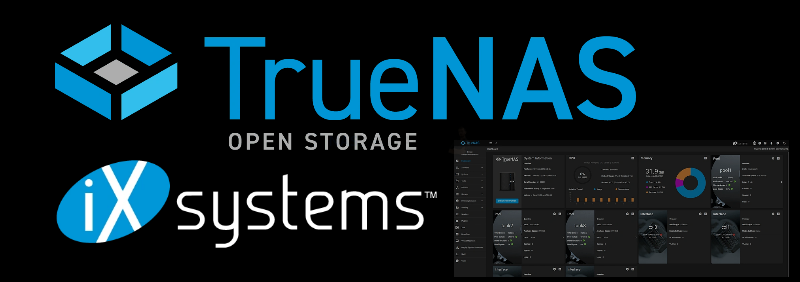 |
 |
|
|
Although the majority of NAS systems can be accessed via 3rd party software in your home or business, the majority of users still opt for controlling their NAS system via the browser-based GUI that these systems arrive with. In the case of both Synology and TrueNAS, navigation via all common web browsers is possible and supported on the popular operating systems out there. However, both brands take a notable different approach on how they allow the connect end-user (admin or general user) to interact with the NAS. Synology uses the DSM (Diskstation Manager) platform currently in it’s 7th version and it is widely regarded as one of the most user-friendly user interfaces out therefore managing your NAS. Styled on the Mac OS (with a little windows and Android settings in places) you are given the feeling of accessing a complete operating system via your web browser.
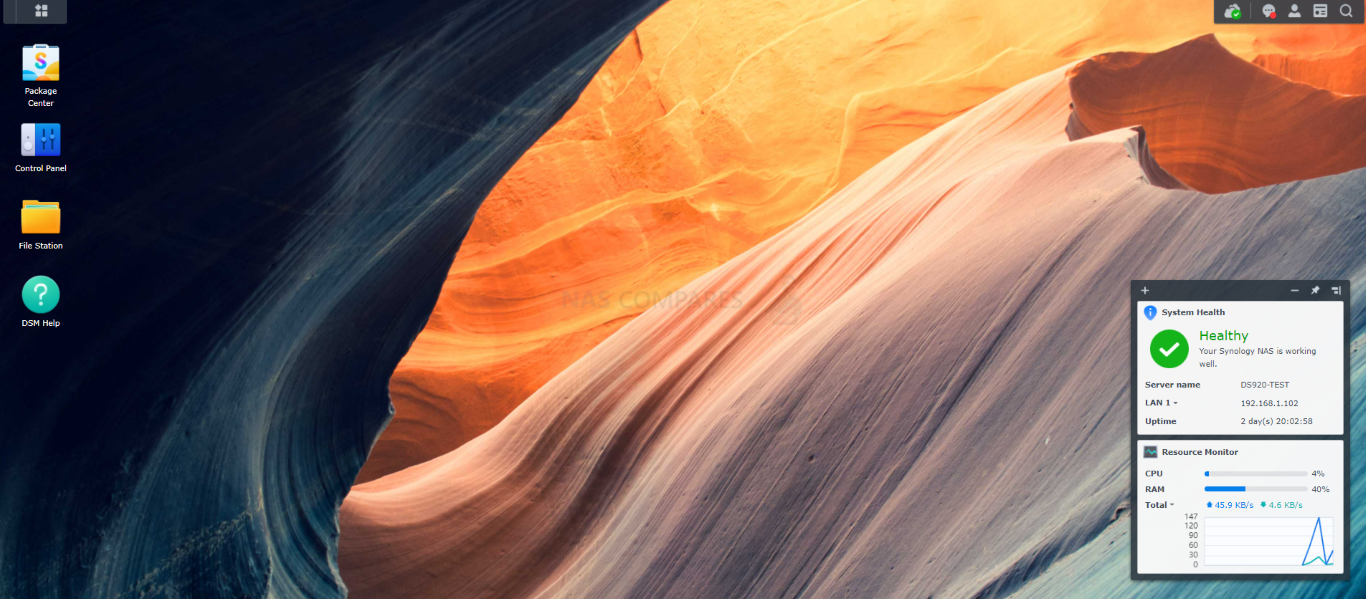
Navigation of DSM is pretty intuitive and the desktop/wallpaper can be customized, alongside the user control options and start menu largely being where you would expect them to be. This opens out into a greater range of software and system control options, presented as icons.
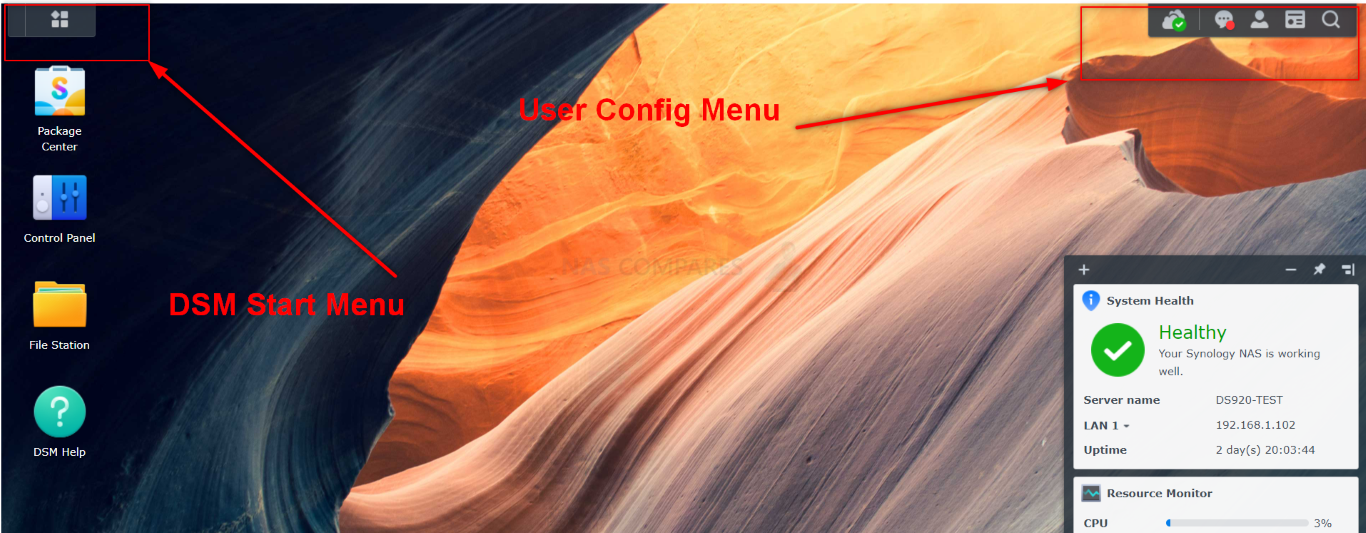
The arrangement of the tools and applications that the system arrives with (as well as those you choose to add later from the app center) are all presented here and you can choose to drag and drop these onto the desktop if you so choose. It feels incredibly straightforward and easy to use.

TrueNAS has a little bit more of a technical stance and whereas Synology has opted for emulating common domestic OS’ and making it chewable-easy-user-friendly, TrueNAS Core (version 12 for this comparison) favours providing the end-user with a tremendous amount of information and control in it’s GUI. TrueNAS (formally FreeNAS) is a platform that, despite its open-source and free availability, does not scrimp on the control and services that it offers in terms of managing your storage. The primary screen of the TrueNAS Core GUI presents lots of details about your storage, network, system hardware health and attempts to fit all this into a single screen (something that will eventually overspill as more services and storage targets are added over time). It can be quite overwhelming at first glance, but you cannot deny that TrueNAS is providing you with much more information at initial access than DSM.
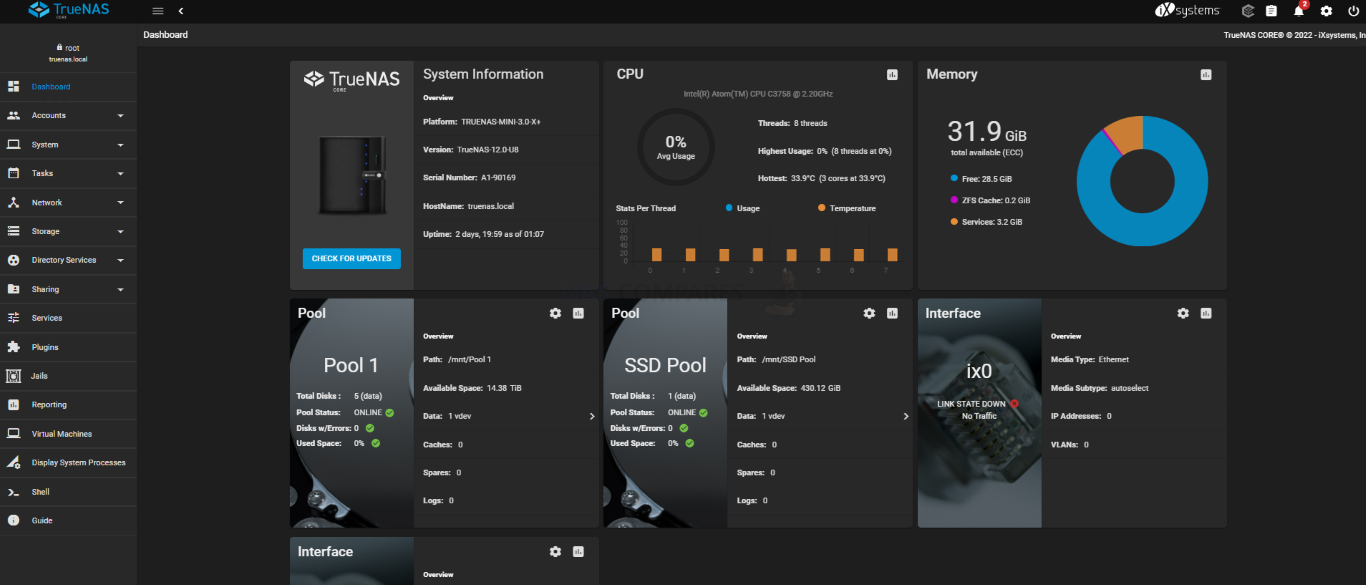
Of course, this larger array of information, options and configuration choices so early on leads to quite a high learning curve requirement from the GUI of TrueNAS in your initial use. The display and theme customization of the GUI can be reached from the top right of the screen as you might intuitively expect. As with the desire by the designers of TrueNAS to allow practically all controls and tools to be accessible from that initial screen, all the options to navigate system management, changing settings, adding services and accessing 3rd party applications you choose to install are ALL listed in a breadcrumb style list of options on the left-hand side of the screen (each branching out into their subcategories.
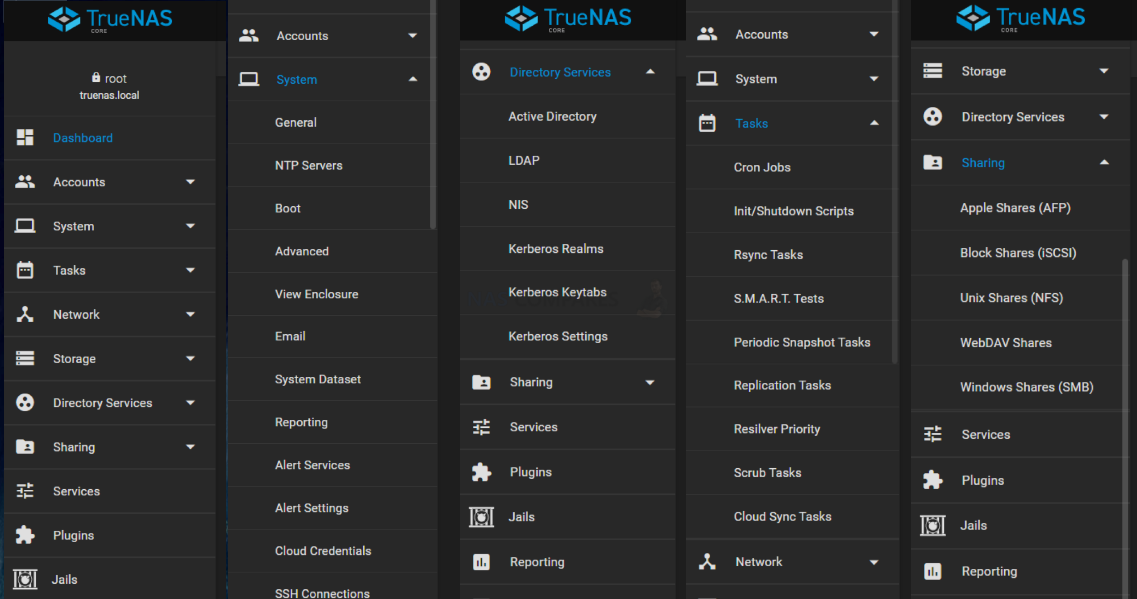
Now, unlike the Synology DSM approach of trying to emulate an operating system, the GUI of TrueNAS is much more comparable to WordPress and control panels of web servers and switches. It is a greater degree more technical and whilst trying to find a middle ground between the accessibility of tools and customization, it can be quite daunting. To access the tools and applications that you install from the community pool of apps, you need to head into the add-on area and you can access their own respective GUI from there. This is still customizable and you can make additions to the primary GUI window of TrueNAS, but it is not something that you are going to click with immediately unless you have greater experience of more factual GUIs
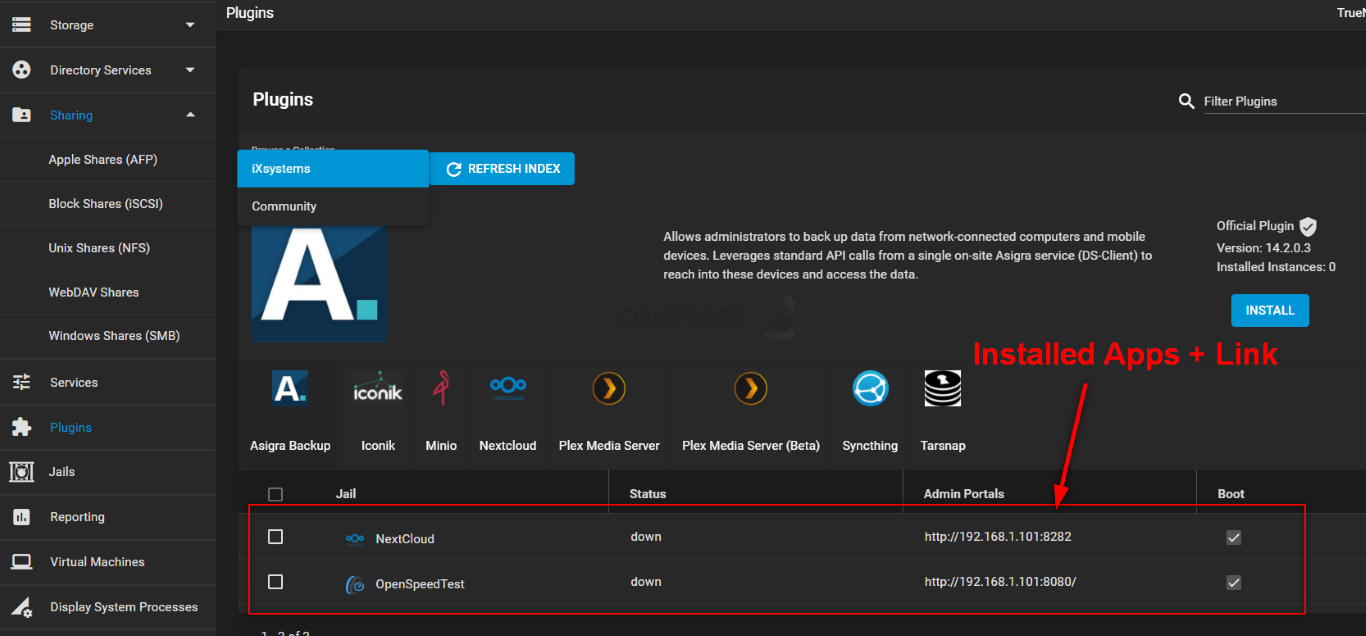
Another quality of life design choice in DSM7 from Synology that is worth highlighting is the inclusion of a search functionality built into the main window of the GUI. This allows a user who is looking for a specific setting, service, tool or file to search the system quickly and easily. This is a small extra that is absent on TrueNAS but clearly something that has a place in modern software GUIs and OS’ (as this is all too often how most people navigate their platforms – gone are the so, so precise days of the Windows XP, Vista and 7 ‘Start’ menu – sigh). I am very surprised that this is not something available on TrueNAS as it would hugely counter the menu-overload that the GUI can cause at times for the less experienced.
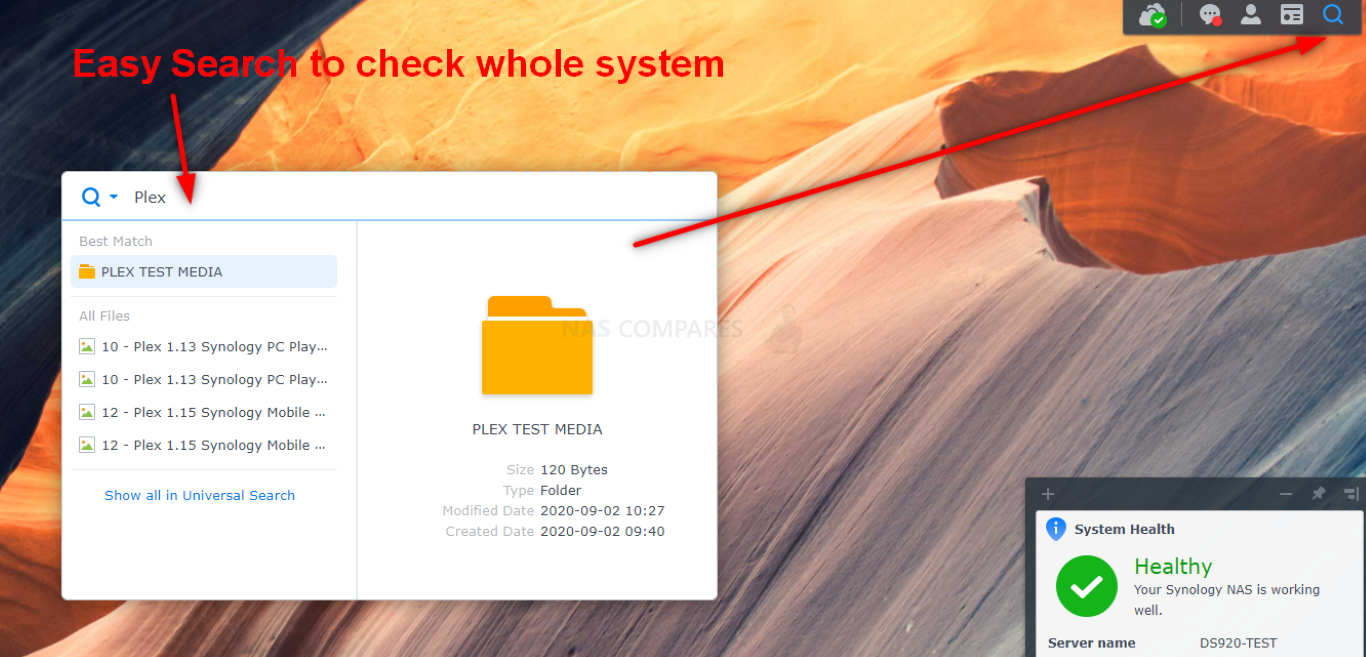
However, when it comes to the areas where most users (especially the admins and techies) WANT more details and info at their fingertips, TrueNAS is largely unbeatable and one prime example of this is in the resource monitor and reports on how the system is performing. The TrueNAS platform provides a frankly insane amount of both live and historical information in the drive media, the pools, the interfaces, the system hardware, EVERYTHING! this information can be broken down into completely bespoke reports with numerous X/Y access variables. This is done incredibly quickly and all this is provided in the free TrueNAS Core and Scale, not just the premium TrueNAS Enterprise platform.
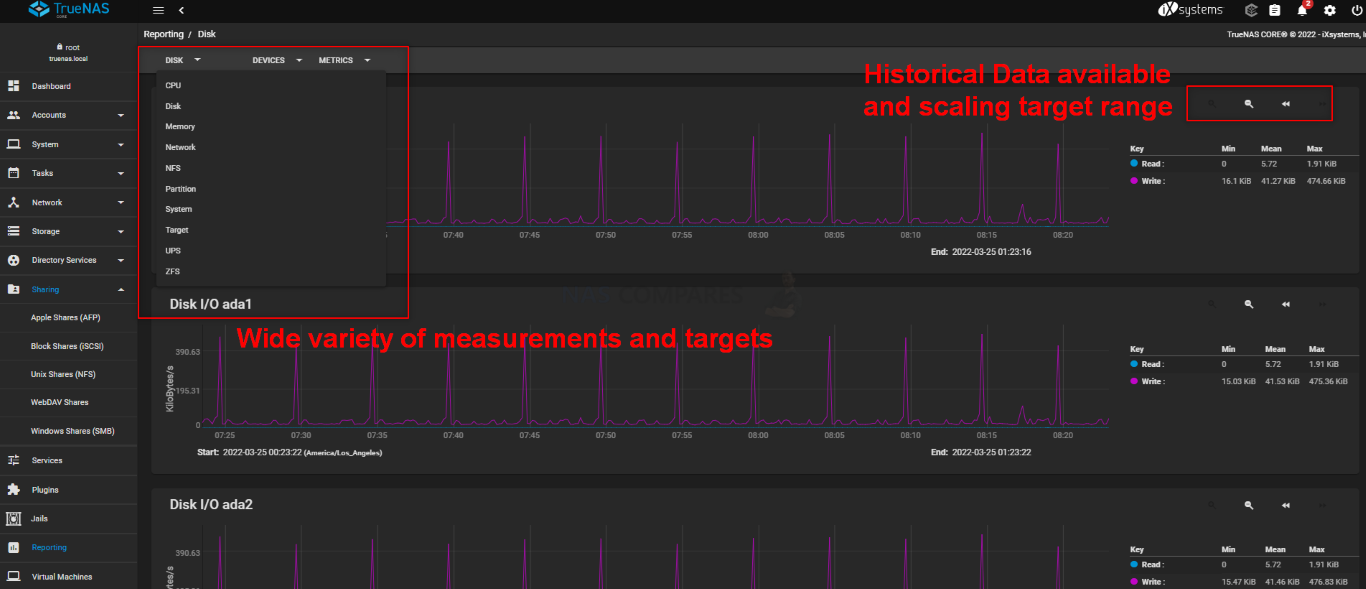
DSM 7 from Synology on the other hand is a little lighter on the details. You have a very barebones activity monitor on the initial GUI login via your browser in the bottom right corner (intentionally, to not overwhelm the user) which can be opened out easily into the dedicated Resource monitor. This monitor DOES provide a good amount of information on the system hardware, network and storage, but it is a little bit tame and limited when compared against the resource monitoring of TrueNAS. Likewise, you CAN enable historical information, but this is disabled by default and even then the level of information is still a little more limited by comparison to TrueNAS.

Now it is worth mentioning that Synology DOES have a much, MUCH more analytical and detailed system health monitoring service available in the form of Active Insight, that allows you to really, REALLY breakdown the health of your system+storage (as well as multiple other NAS systems in a single GUI) and produce some staggering detailed reports to be generated in the GUI or emailed to system admins/managers. However Active Insight is a subscription service and not available by default with your Synology NAS purchase, so although it IS available, the fact that this is an additional subscription locked model will put some users off a little.
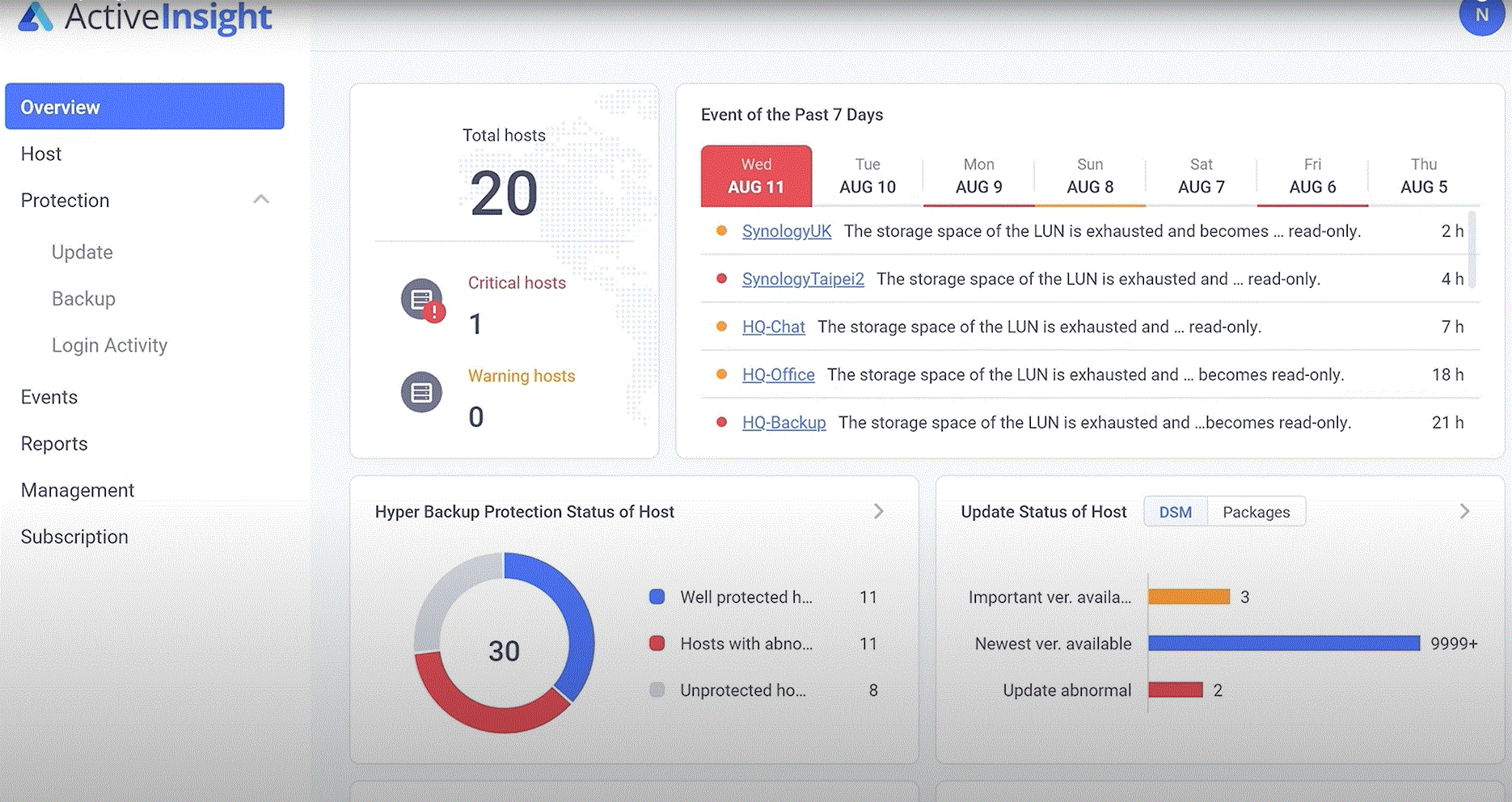
Overall the user-friendly design, ease of use and intuitive design of Synology DSM genuinely cannot be understated, making it considerably more appealing to newer users and those who want a clear pathway toward their intended system setting, service or application. TrueNAS Core on the other hand is a significant degree more technical in its approach and can be both complex to navigate for the less novice user and intimidating to those fearful of making a miss-step when managing the system. This ends up meaning that the move overwhelming TrueNAS GUI can be a gold mine of control and information compared to DSM 7 for those that are willing to put the time in to learn. Whereas Synology DSM is considerably easier to navigate, but the extent to which it can be adapted and controlled via the GUI is also much less customizable.
Synology DSM 7 vs TrueNAS Core – Users & Customization
As soon you have established your TrueNAS or Synology NAS system, you are likely going to start customizing the system to your own specific network and requirements. Most of the time this means that you will want to create several users, groups or system identities for applications to access your storage and in turn grant those accounts with their own range of storage access privileges, system powers and security settings. Both Synology DSM and TrueNAS Core allow you to do this, but once again the way in which they do this and the extent to which this can be approached differ noticeably on these platforms. Synology has an option in its control panel to allow you to create multiple user accounts, then give those individual accounts access to pre-defined folders and storage, as well as system application access, quotas and even rules on password validity. This is then further built on with similarly approached group structures with those same customization options, but also allows you to move one or more users in between groups to adapt their access/quotas as they move (useful for company staff and their teams).

TrueNAS offers a very similar level of creation and control in user and group creation, squeezing the window-by-window creation that DSM uses in its user-creator windows into a single window – which as you might expect is a great deal more informative BUT is another bit of detail overload at times once your system and structure increases in complexity over the years). In the case of both TrueNAS and Synology DSM 7, these user accounts each allows the owner to access the NAS in a separate/parallel access login via the GUI and connected services, as well as having security and access rules in place that can block malicious access as needed. These rules and access rights can be adapted on the fly by the admin easily on both DSM and TrueNAS.
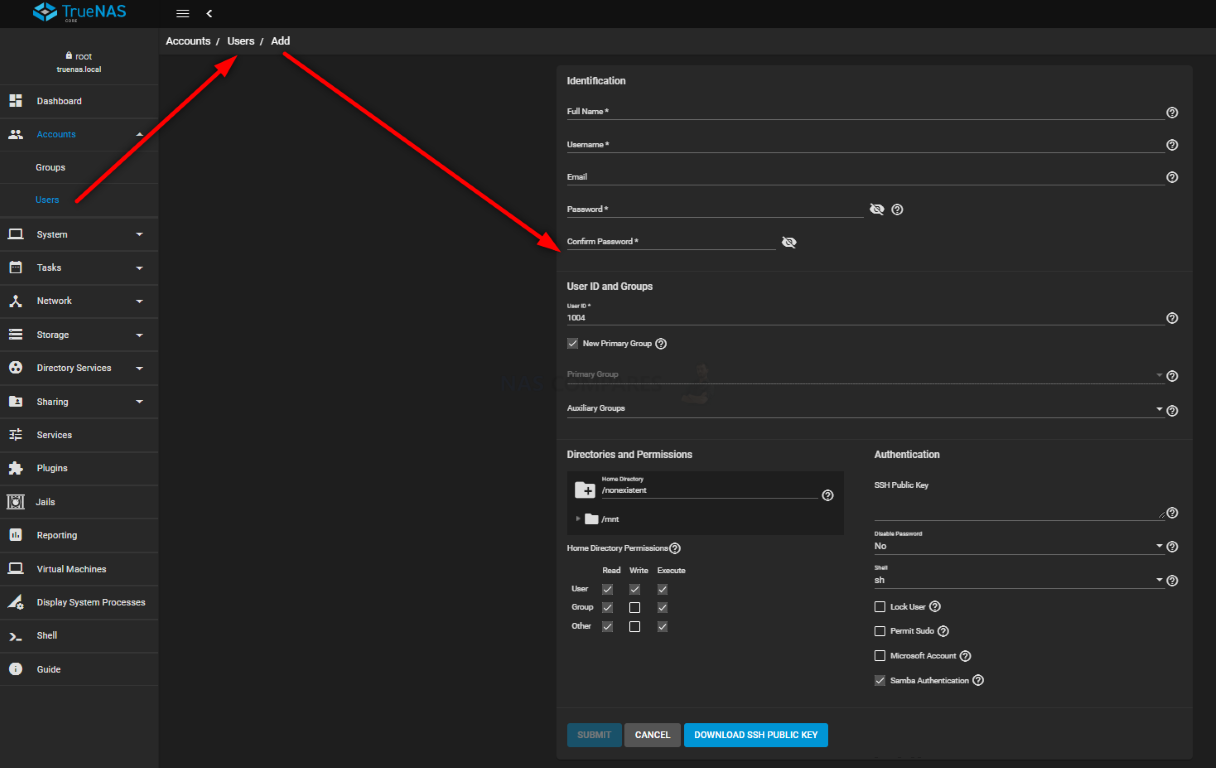
One thing that is absent in TrueNAS (which is available to a degree in TrueNAS Scale however) but IS available on DSM is the option to create bulk accounts quickly, as well as upload an existing CSV of user accounts to the NAS. For those that are migrating from an existing database and want to move their user data over (and then move these users into groups), this is going to be a useful extra option. Not something for the long term, but a nice initial service nonetheless.

Both systems allow you to adapt the admin powers of existing users quickly, but it is also worth highlighting that the Synology NAS platform allows you to change a user’s credentials and access temporarily higher in a semi-automated ‘delegation’ option in the user control UI. TrueNAS has a similar setting to this, but lacks the timed management and ease of switching on the fly in how it is presented in DSM.

The design of the GUI in your web browser on both TrueNAS and Synology DSM are both a little rigid in just how much you can adapt what you can see and change to your liking. Both platforms allow you to change elements of the colours on screen and user login avatar to a point, however, the TrueNAS platform provides a much wider degree of choice of customization, thanks to its theme creator. This allows you to choose between a range of present colour/icon themes, as well as create your own colour pallet, font scale/detail and adapt the icons to your liking. Its only a few minor extras, but it is something that no other NAS platforms account for in their customization.
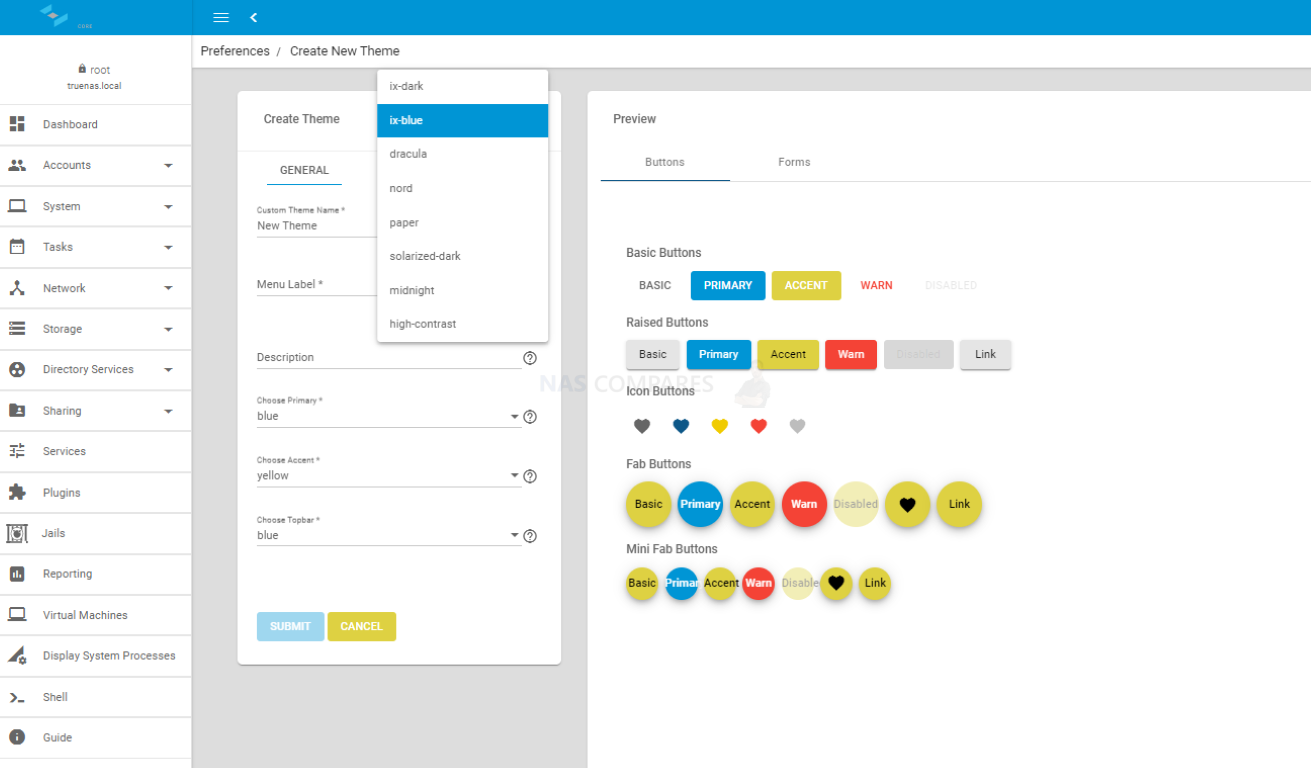
The Synology customisation in its GUI is a lot more limited, however, with the wallpaper, text sizing and icon changes being the only real options. That really surprises me, given the operating system vibe that DSM provides in the web browser GUI.
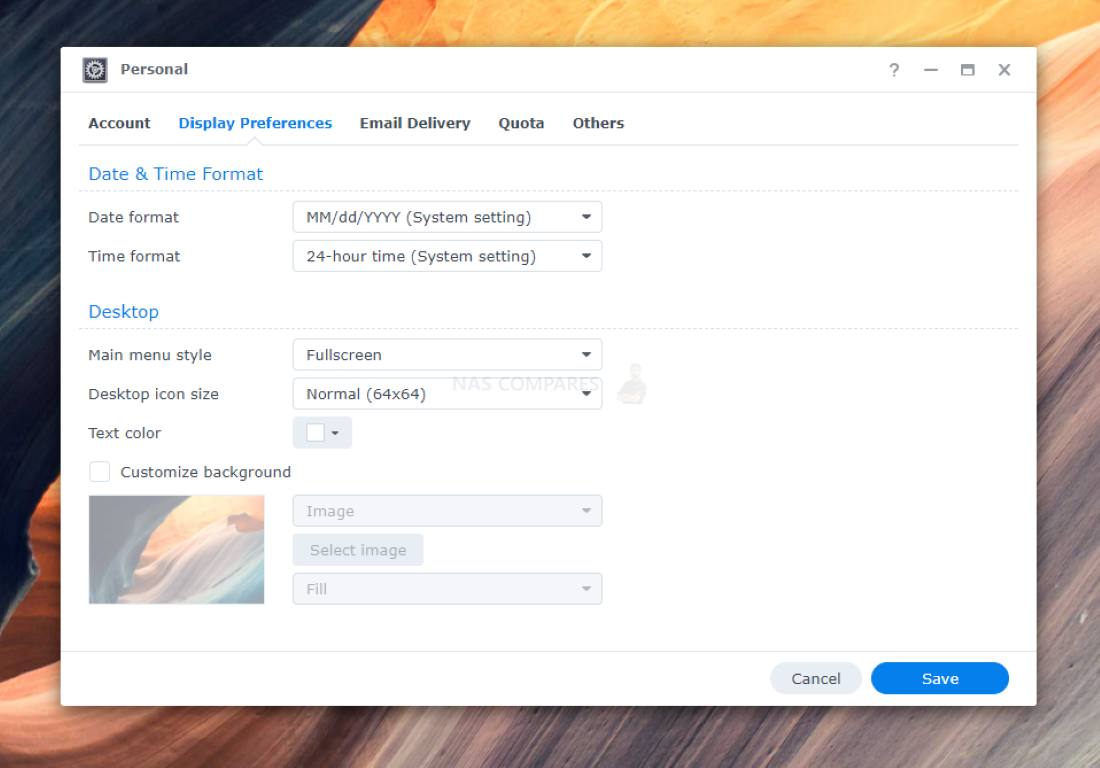
Overall, this is another case of Synology DSM being more user-friendly than the TrueNAS platform, but both platforms provide a similar level of user creation and customization. That said, the Synology DSM platform is pretty rigid in how you can customize the GUI in terms of fonts, icons and structure (only really offering the wallpaper and icon changes really) compared with the custom theme creation built into TrueNAS. That sad, bulk user creation and the option to import existing CSVs of users onto DSM are an often overlooked but huge time saving extra that I was surprised was not available on TrueNAS Core (but available on SCALE sort of). Overall, I think more complex user creation is going to run better on the TrueNAS platform, but fairly straightforward and larger-scale user creation is going to be much faster and easier on Synology DSM.
Synology DSM 7 vs TrueNAS Core – Storage Management
Almost certainly one of the biggest questions most users will have when considering TrueNAS and Synology DSM for their own private NAS server is how it manages storage. From how it keeps it accessible and stable, to how it reacts and adapts to changes in stability, these two NAS platforms have chosen their intended path very early and differ in some key ways. TrueNAS utilizes ZFS as its file system of choice and although it is a little more resource-intensive (predominantly in memory) to run its range of services, it is a fantastically enterprise file system that supports native inline deduplication across the system (i.e if data is being backed up from multiple clients is the same, such as OS data or shared databases, it only stores one copy and keeps an internal index of where that data is needed/stored across users), inline compression that saves storage space and a bunch of other advantages that are unique to ZFS. Synology and it’s DSM platform is (for the most part, barring some more economical devices in their portfolio) available using the BTRFS and EXT4 file systems.
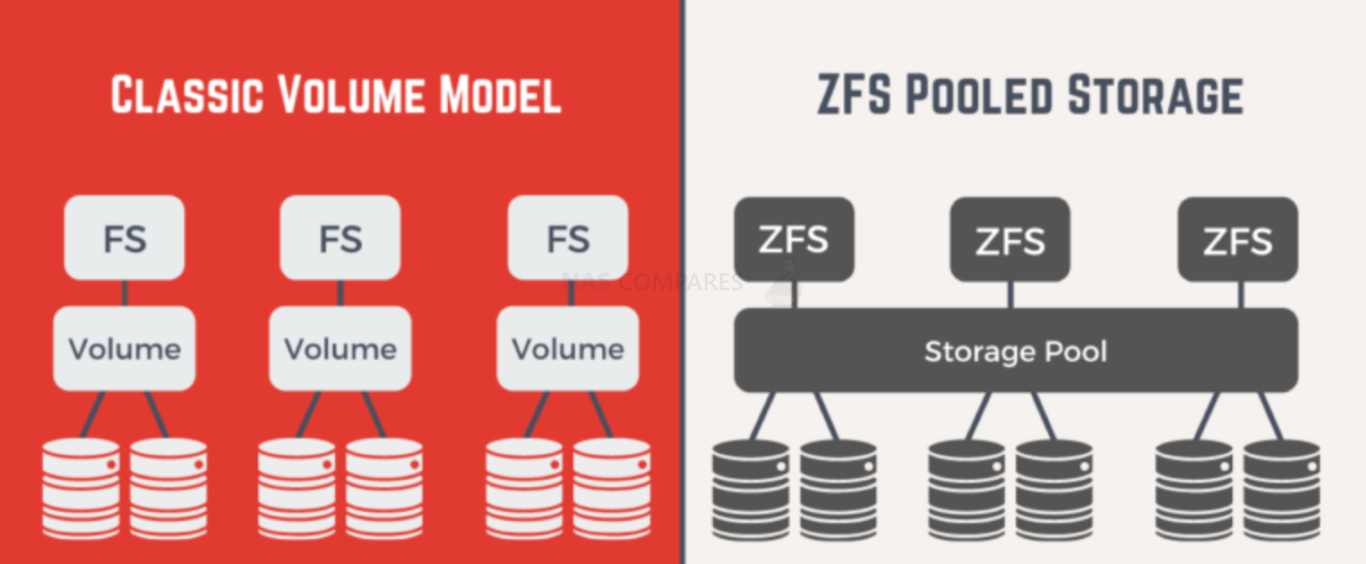
Although EXT4 has a long-established history and support by storage users, BTRFS opinion is a little more divided as it is much newer than EXT4 or ZFS. Alot of that comes down to how BTRFS is implemented by the system, but in the case of Synology and DSM it is done so quite comprehensively and on the ground level. Indeed a number of key Synology applications insist on the use of BTRFS by the system in order to run (eg Synology Virtual Machine Manager). Both BTRFS and ZFS use a checksum/background comparison system on writers in order to identify errors and auto repair them, as well as both DSM and TrueNAS supplying a faster RAID rebuild system whereby only the areas of a rebuild drive that would have had data on them are built and the rest zero’d out. They also both provide low-resource consuming snapshot creation in the background and the ability to store many, many thousands of snapshot images with customized retention policies. There are lots of other similarities and differences to go through, but for now, let’s look at how Synology DSM and TrueNAS Core display your storage in the GUI.
| ZFS | BTRFS | EXT4 |
|
|
|
The Synology DSM Storage Manager GUI has received a relatively recent design change over the DSM 6.2 version and although it still continues with maintaining a high level of user-friendly design and ease of use, it features a little more graphical structure than previously. With Synology DSM only being commercially available when included with a hardware NAS purchase, it allows the graphical GUI to be a lot more specific to the NAS in a way that is not really possible in the open-source and DIY nature of TrueNAS. There are numerous options to set up a new storage pool, set up a hot spare, create your volumes, enabled intelligent caching with connected SSDs (SATA or NVMe) and there are a few extra options to allow auto RAID repairs and more. It provides all these settings whilst still maintaining a very easy to follow GUI.
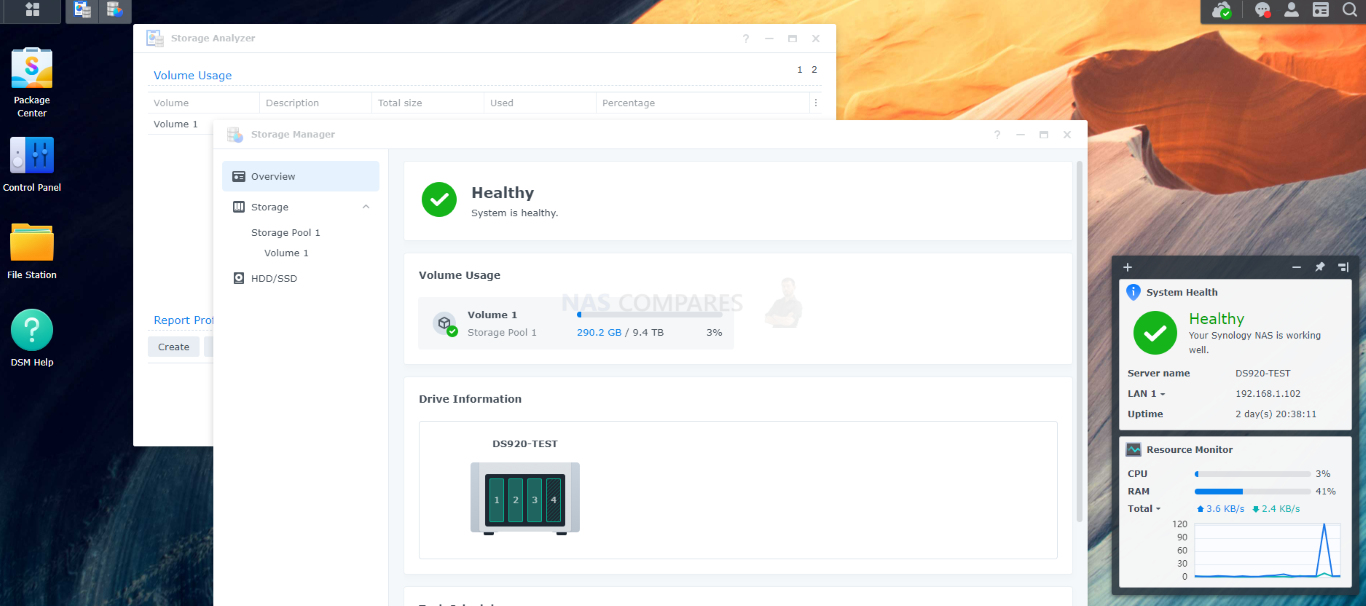
The TrueNAS storage manager on the other hand, although EASILY more configurable and customizable to your needs, is also much, much more text/stat based and the configuration and creation options are built into a series of native settings menus on the side of each storage container. There are the ZFS specific details, such as adjusting and monitoring the inline compression/deduplication output, as well as the creation of volumes, data sets and further pools all being much more text-heavy. You do have a greater deal of control and flexibility in the storage manager in TrueNAS (as you expect) but it can be quite overwhelming and certainly not recommended to the novice.
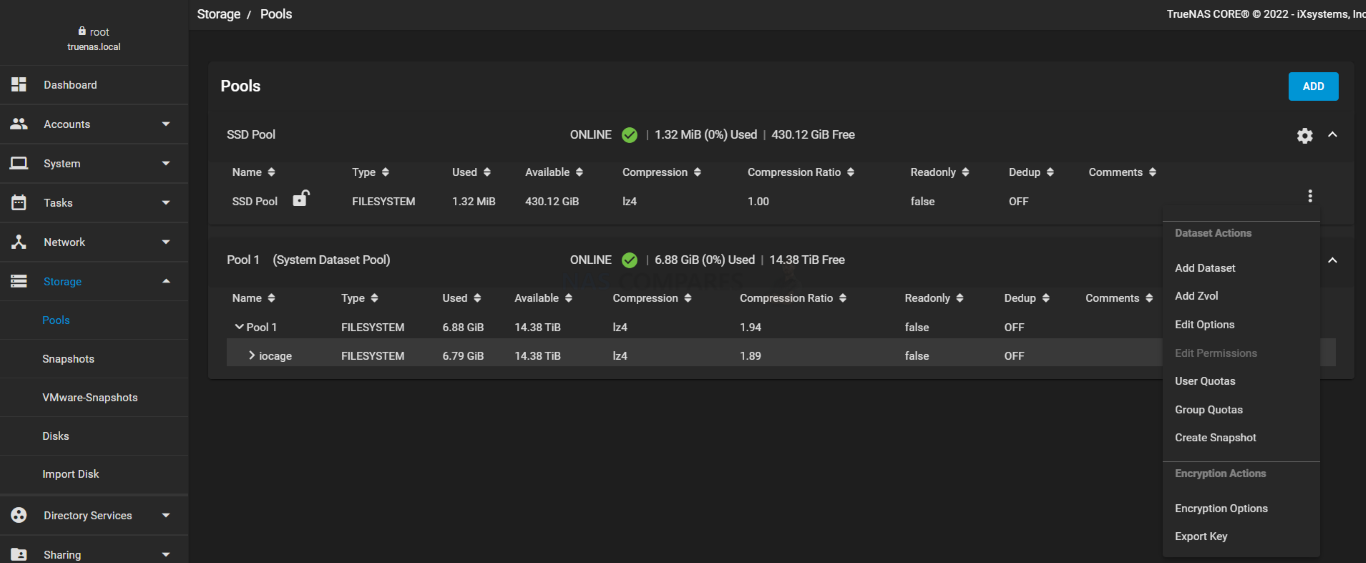
Another consideration of choosing between TrueNAS and Synology DSM based NAS is how each system tackles the subject of redundancy in the storage. For those unaware, the bulk of storage systems in the world (NAS or DAS, which is direct-attached storage such as USB) that utilize more than 1x HDD/SSD media drive take advantage of something called RAID (redundant array of independent disks) which allows you to combine multiple media drives into a single pool of storage This is further bolstered by increases in performance (as multiple drives are read/written at once) and also allows safety nets for if one of the drives fails (known as redundancy). If, for example, you have 4 drives in a RAID that supports 1 drive of redundancy, it means if one drive was to malfunction, your data is still accessible and the RAID can be reverted back to normal when to install a new drive back into the system to replace the bad one. Now, this is all quite important, as TrueNAS+RAIDZ and Synology DSM+SHR+EXT4-RAID provide different benefits. Synology has its Hybrid RAID system (not available on the enterprise tiers) that allows you to mix and match drives in a way no other RAID configuration allows. In a traditional RAID, you need all HDDs or SSDs in the RAID to be the same capacity, otherwise, the redundancy and parity calculation will view all drives as the smallest available drive for stability (eg 4TB+4TB+4TB+1TB = 3TB storage in a mixed drive setup in normal RAID5). In Synology hybrid RAID you can mix the drive capacities, as it views the drives but calculates the redundancy and parity about the LARGEST available drive (so eg, 4TB+4TB+4TB+1TB = 9TB in a mixed SHR pool). This may sound silly on day 1, but after a few years of storage on your NAS, you may want to start introducing larger drives and expanding your pool of storage – so adding/mixing larger drives later will make ALOT more sense. Additionally, an SHR is much easy to expand and add more drives with an expansion enclosure than both EXT4 and ZFS.
ZFS on the TrueNAS platform does not have a flexible RAID configuration and instead, provides other advantages. RAID building (aka RAIDZ, RAIDZ2 and RAIDZ3) is much, MUCH faster to build than RAID configurations, taking minutes as opposed to hours to finish synchronizing. Additionally, along with the fast RAID repair option that both DSM and TrueNAS provide, on a RAID Z3 configuration, you can create a 3 drive redundancy setting (i.e. create a RAIDD storage pool that can withstand up to three drives failing and still allow the data to be fine and RAID recoverable). For high-level enterprise users whose data is mission-critical and particularly in much, MUCH larger RAID arrays (12-24 bays and above on the hyper-scale) 3 disk redundancy is invaluable.
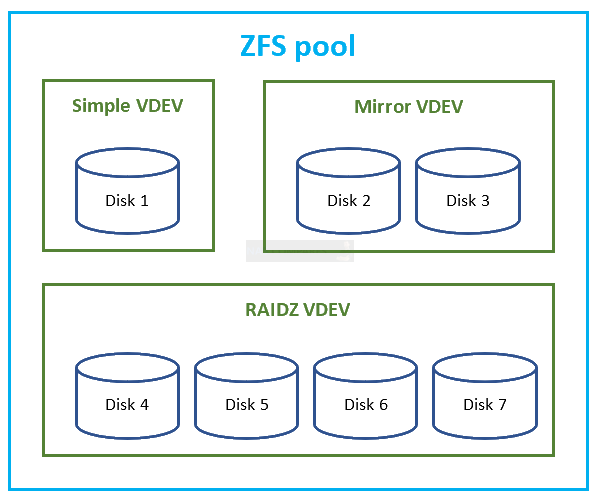
Synology provides up to 2 disk redundancy in RAID6 and SHR-2, but no real triple disk redundancy (though a somewhat haphazard version can be built with an SHR on two drives and adding more drives – much less efficient), however expanding your storage pool with larger drives or more drives on TrueNAS is not really viable. In Summer 2021 there were details on the means to expand your Storage Pool on ZFS/TrueNAS, but this system involves the added drives to live parallel with the original pool in a 2nd RAID group, running side by side technically (although only a single larger pool being visible) and being much less efficient.
| RAID5 example of parity | 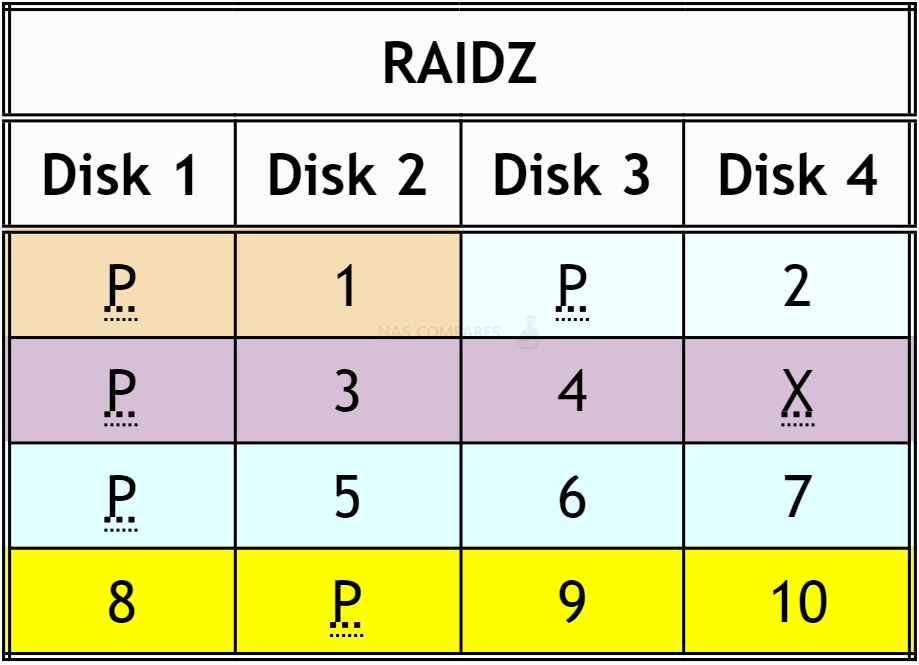 |
|||
|---|---|---|---|---|
| Disk 1 | Disk 2 | Disk 3 | Disk 4 | |
| 1 | 2 | 3 | P | |
| 5 | 6 | P | 4 | |
| 9 | P | 7 | 8 | |
| P | 10 | 11 | 12 | |
In TrueNAS, choosing what you want to do with your connected storage media is broader in scope and creating pools, caching, fusion pools (when HDD+SSDs are combined for intelligently faster storage pools), hot spares and more is surprisingly well guided to the end-user. Equally, when creating your areas o storage, if you are creating an unrecommended or unstable setup (such as mixing storage media types in a traditional RAIDZ pool, mixing capacities, using unsuitable slower media for metadata and more) the system will warn you regularly throughout the build process and will not proceed until you choose to ‘force’ this option in the storage manager.
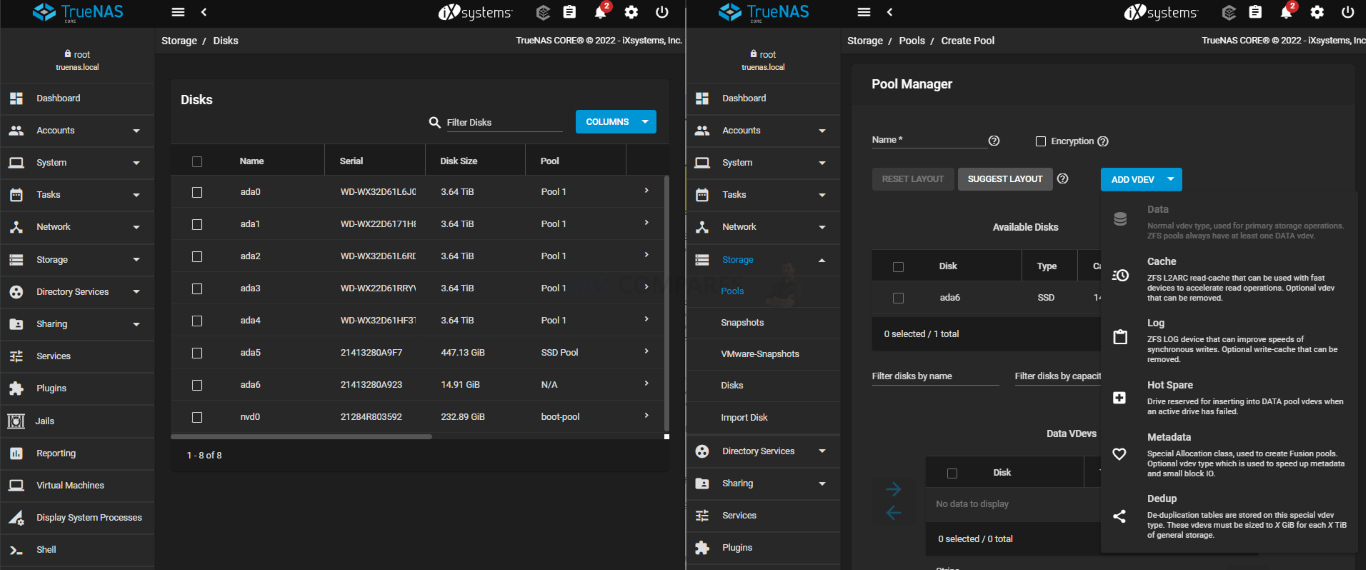
In the case of Synology DSM and its storage manager, there is a guide option that presents the end-user with choices on what do with an available drive, but they are a little more limited in scope and choice. Additionally, in most cases the Synology if you are running a setup that is less suitable will not let you proceed (no force it option in most cases). Finally, there is the subject of NVMe SSDs and Synology NAS. Despite Synology being one of the very first commercial NAS brands that offer off-the-shelf solutions to offer NVMe SSD support on their hardware, you can ONLY use NVMe SSD media on the Synology NAS hardware and DSM as caching, not for use in traditional storage pools. This will come as a bitter blow for some who have seen the prices of PCIe Gen 3 and even Gen 4 NVMe SSD storage become much more affordable. NVMe SSD use in Synology NAS hardware for caching is certainly beneficial and something that is widely available on this platform, but the lack of choice for the user to pick whether to use it as caching or as super-fast storage is a shame.
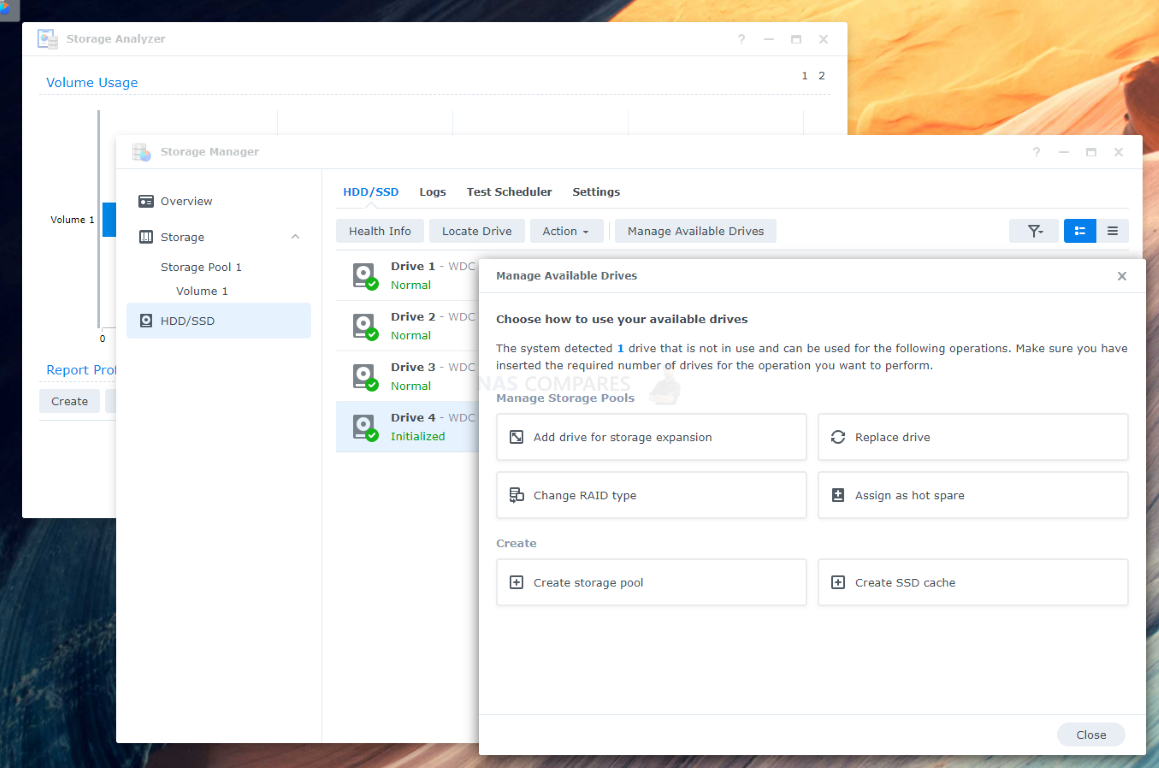
Another area of contention around the Synology NAS platform in recent months that might have played a part in why you are reading this article, is the brand’s recent change in the compatibility and DSM services policy on hard drives and SSDs on enterprise/big-business solutions. Synology currently provides a range of high workload, performance and durability Hard drives and SSDs in their portfolio that can be used in conjunction with all their NAS hardware. This media is rather good (as well as allowing users to upgrade the firmware of this drive media from with the Synology DSM software, something NO other commercial NAS brand offers). However, things get a little disruptive when the brand stated that their 2022 and onwards enterprise releases (such as the DS3622xs+ and DS2422+) will only provide all the software services in the storage manager to their own storage media drives, with 3rd party HDD/SSDs from brand such as Western Digital and Seagate in their respective WD Red and Ironwolf ranges) having fewer drive tools available and the system stating a warning status when using these drives. This rather divisive move by the brand (although only at the enterprise level and likely as a means to emulate top tier modelling from the likes of HP, EMC and NetApp) is something that currently does not affect the bulk of the Synology hardware available though and should only be a consideration to factor in at the higher tiers.
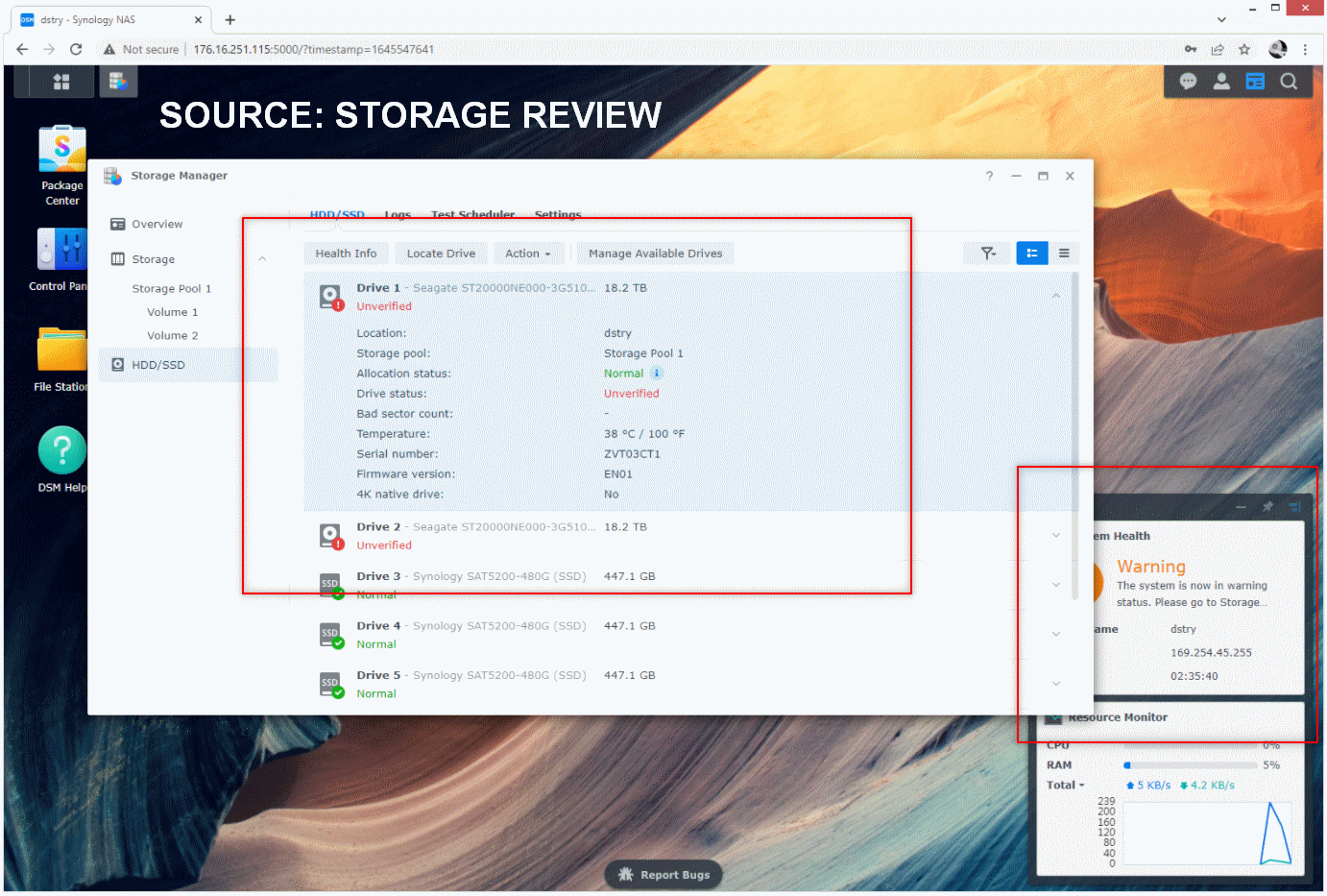
Returning to the subject of expandability, it is worth highlighting that although the expansion of RAID pools on TrueNAS is not really straightforward or efficient currently, the open-course nature and ZFS build of it DOES make hardware migration of an existing RAIDZ Pool into a new system considerably easier than it would be on a Synology NAS in DSM. Synology only allows hardware migration of RAID Pools in the Synology hardware ecosystem to stay within that same ecosystem and hardware which is larger and running the same version of DSM. TrueNAS and ZFS on the other hand is much more open, allowing you to exchange the storage pool directly into any DiY/Custom TrueNAS server as additional pools (eg, no need to replace the existing pool, just add it as another one in another enclosure, even a DAS over USB) and is also open source by design, so it will not lock out connectivity on a software level years and years later on a foreign system. As long as a system can see/understand ZFS (internally or as an external connection), it will be able to see your RAIDZ pool.
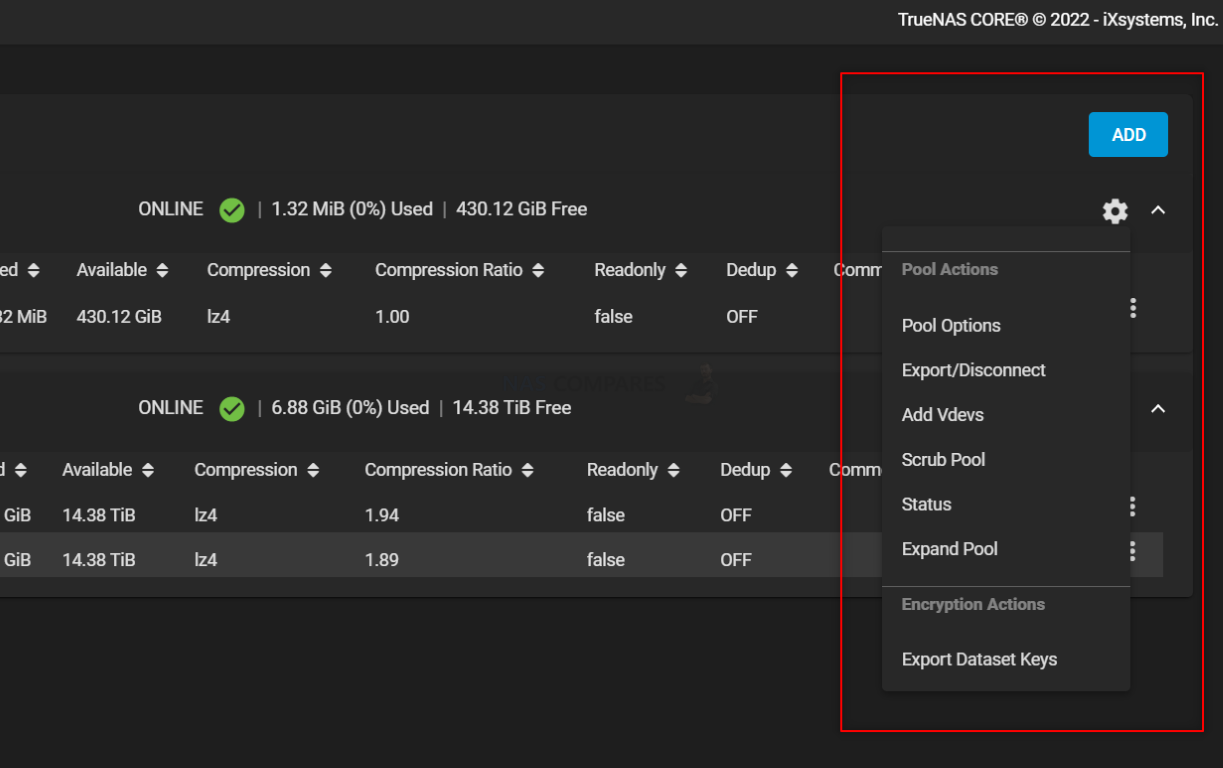
Once again, it should come as zero surprise that the TrueNAS platform is the more detailed, technical and least user-friendly BUT it also seems to have a greater degree of options in terms of long term mounting of the storage if your TrueNAS system fails or gets upgrading. Likewise, the appeal of overall faster RAID building, rebuilding and resilvering on TrueNAS with the bonus of triple parity will comfortably win over a lot of seasoned storage managers and admin managers with the time and knowledge to craft the ultimate storage system. That said, the Synology storage manager and the advantages DSM brings to their platform cannot be overestimated. BTRFS although a little greener in the eyes of some than ZF, is way, way less resource hungry and still provides data parity checks and file self heeling. Additionally, the flexibility of Synology Hybrid RAID and how it allows you to expand your storage on the primary Synology NAS system AND when connecting expansion chassis is something that is simply not available or poorly compared on TrueNAS currently. Synology’s policy on enterprise systems and HDD/SSD compatibility might be the thing that let’s this all down, as well as SHR not being an enterprise-level service on offer (not available above the PLUS series). But regardless, both Synology DSM and TrueNAS Core provide a huge level of storage capabilities.
Synology DSM 7 vs TrueNAS Core – File & Folder Remote Management
When it comes to accessing the data on your NAS on a file and folder level, I think it would be fair to say that Synology DSM and TrueNAS Core have quite differing views on this, especially when it comes to browser level access. Having all of your data in a stable, secure and robust hardware storage server is all well and good, but what good is it all if you cannot access it and via the means that best suit your client hardware. Both systems support numerous popular file protocols and storage sharing services that allow you to view and interact with your storage in their respectively tailored ways (mapped network drives, network mounted SMBs, remote internet-accessible WebDav protocols, iSCSI Targets & LUNS and many, many more. However, after that, the distinctions between Synology DSM and TrueNAS Core in web browser access and tailored proprietary file/folder access becomes very notable. Of the two, Synology DSM is much more accessible domestically and uses less complex means. One of the most oddly glaring advantages that less technical users will appreciate that is almost completely absent on TrueNAS is a simple file/folder explorer that is accessible in the web browser. This is not just a bog-standard breadcrumb structure viewer, but is a complete file manager with the ability to copy, paste, cut, archive, compress, view images, bolt-on remote storage, share files and more. This is usable in the DSM GUI on your web browser and is remarkably responsive, as well as client applications for iOS and Android that allow you to remotely access your Synology NAS storage on a file/folder level and manage the contents as you would in Windows File Explorer or MacOS Finder natively. The fact that this is not a native and easy option in TrueNAS is very surprising and although the file/folder breadcrumb structure can be accessed in a much more basic level (as well as in a detailed fashion by 3rd party applications and services) it is a really surprising omission on TrueNAS.
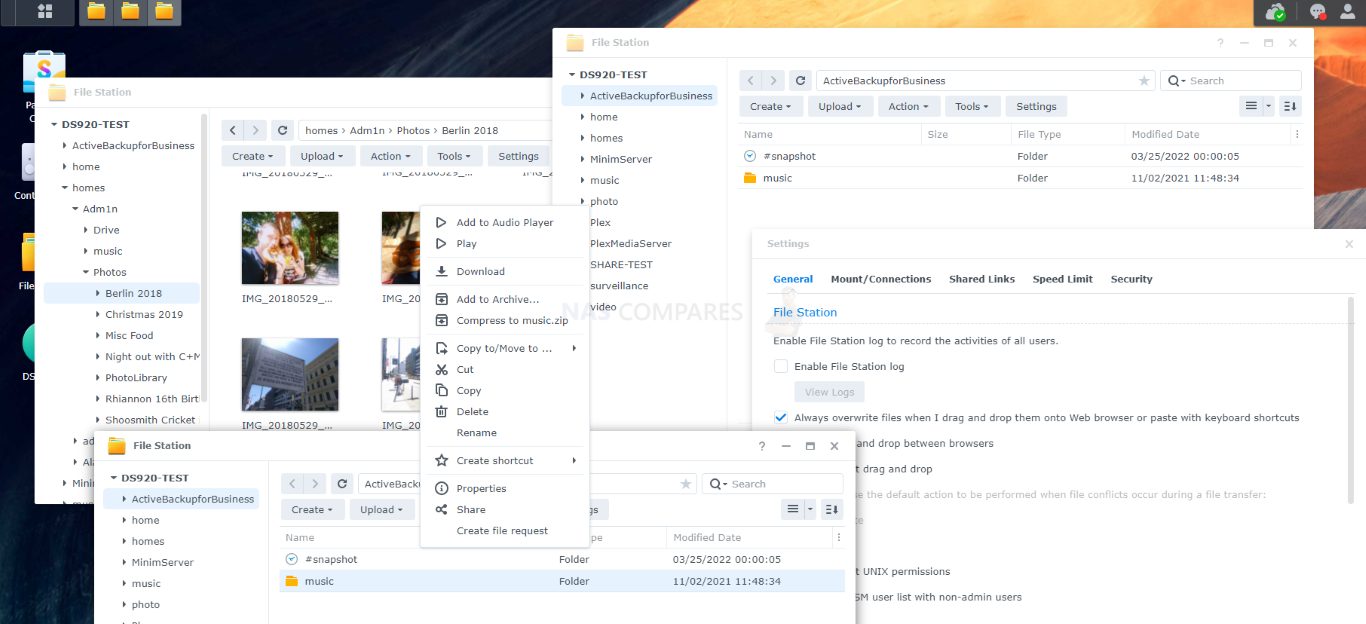
This trend continues further when you realise that there are a huge range of 1st party applications on the Synology DSM platform that are included with your system (licence free, for the most part and include mobile and desktop client applications too for native client hardware connection) that allow you to access the content of the folders on your NAS via their respective formats. TrueNAS has a number of first-party services built into its architecture and although they are no exactly applications, they are services and tools that are available to manage your storage quite comprehensively. Now, DSM has a lot (but not all) of these, but also have the file/folder access options that are not on TrueNAS. Key examples of this tailored NAS access such as Photography management in the Synology Photos application. This tool (with its partner mobile and desktop client apps) allows you to view photos in tremendous detail, create smart albums using photo metadata, using AI-supported services to search photo contents quickly, share photos with customizable rules and even create a professional share space that allows professional photographers to share access to their work with clients and professional colleagues.

Alternatively, there is the Synology media suite that includes music station for managing and customising an audio server collection, Video station to provide a similar level of video file management (including transcoding and metadata scraping) that is comparable to Plex Media Server, iTunes server, DLNA Media server and others that allow you to create smart or generic media server shares and more. Although 3rd party tools to accomplish this are supported on TrueNAS (with several of these tools being accessible in the add-on center of TrueNAS), the range of first-party tools to manage media on the Synology DSM NAS platform is unquestionably better.
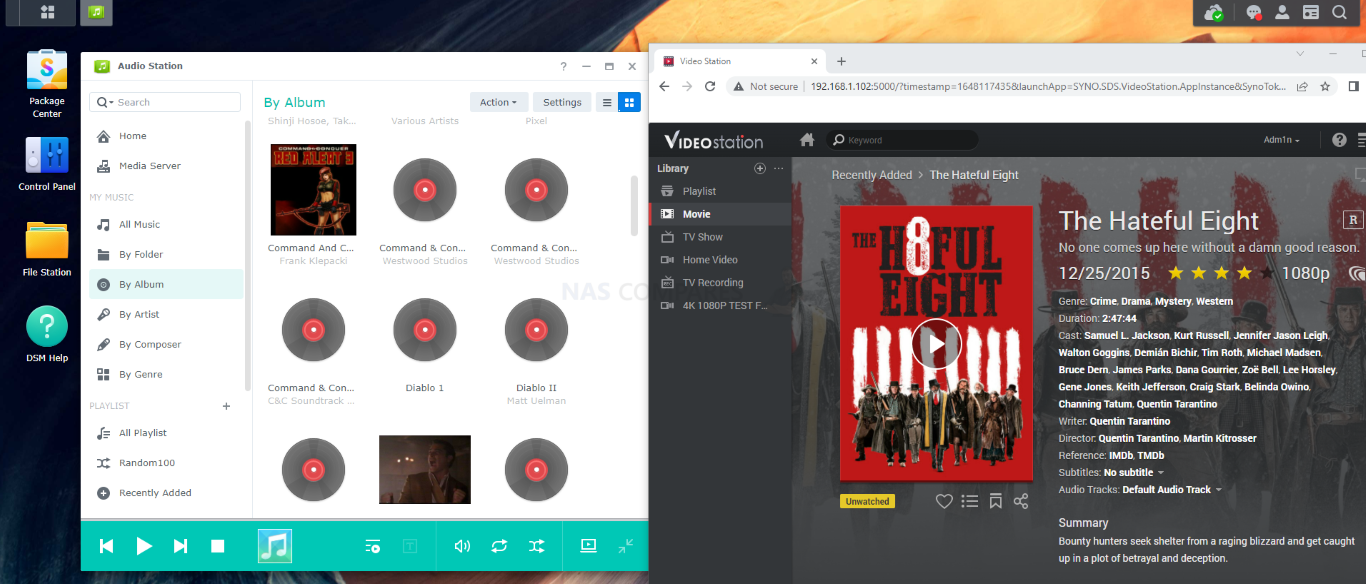
Then you have efforts by Synology NAS and DSM to rival the likes of Google Drive, DropBox, OneDrive and more with Synology Drive. This tool, in conjunction with the Synology collaboration suite) provides you with similar tools to SaaS (software as a service) platforms such as Google Workspace and Office 365. Synology Drive gives you a one portal web browser (and mobile/desktop app) access point to your NAS and can be used to open, edit, share all your files in a tailored fashion. This is done by DSMs collaboration suite that includes Synology Chat (like Skype or WhatsApp), Synology Office (like Office 365 and Google Drive), Synology Calendar, Synology Mail, Synology Contacts and more – a whole office suite of tools. This is further bolstered with Synology Drive local client on your host OS (predominately supported on Windows platforms) to allow file pinning and file streaming services. This means you can see the contents of your NAS file/folder structure, but can choose for it to not occupy ANY space on your PC – then you can just click the option in windows file explorer to access this file and/or pin it permanently. I know I am going on a bit here, but I am just trying to briefly cover how much Synology prioritizes 1st party access to their systems. Companies making the switch to NAS from the likes of Google Drive and DropBox shared storage will be right at home with the Synology and DSM range of servers compared with TrueNAS.
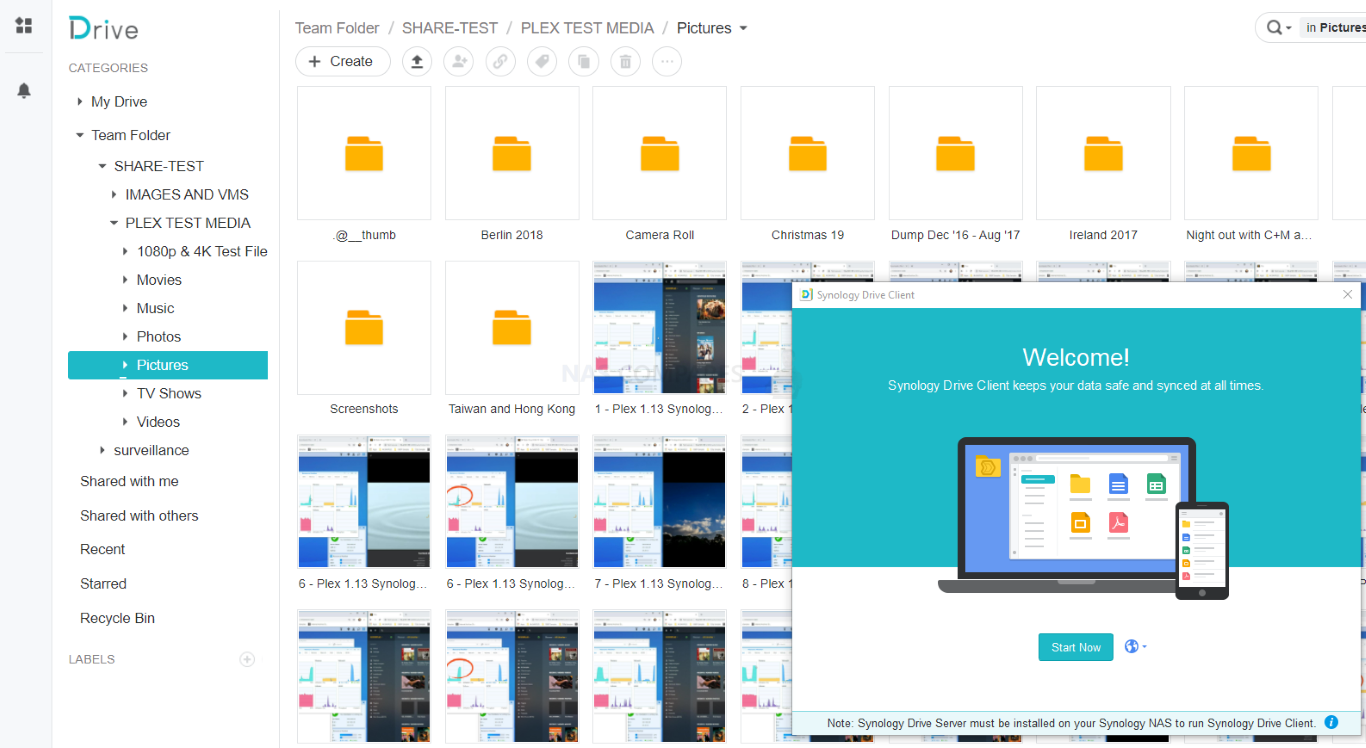
But what if you really just want to use the NAS as ‘dumb’ storage and have it appear as logical storage on your host client systems? This is typically an area where I would recommend TrueNAS over Synology DSM, as this is where the more flexible and wider 3rd party service support of that platform really shines. With a huge variety of services available on TrueNAS (that are securely disabled by default I might add), there is a huge array of choices of how you want to connect with your storage and although the learning curve on setting this up continues to be steeper than with DSM, I think I can safely say that TrueNAS will be able to connect with ANY client software/hardware, whereas DSM might connect with ‘most’ or ‘alot’
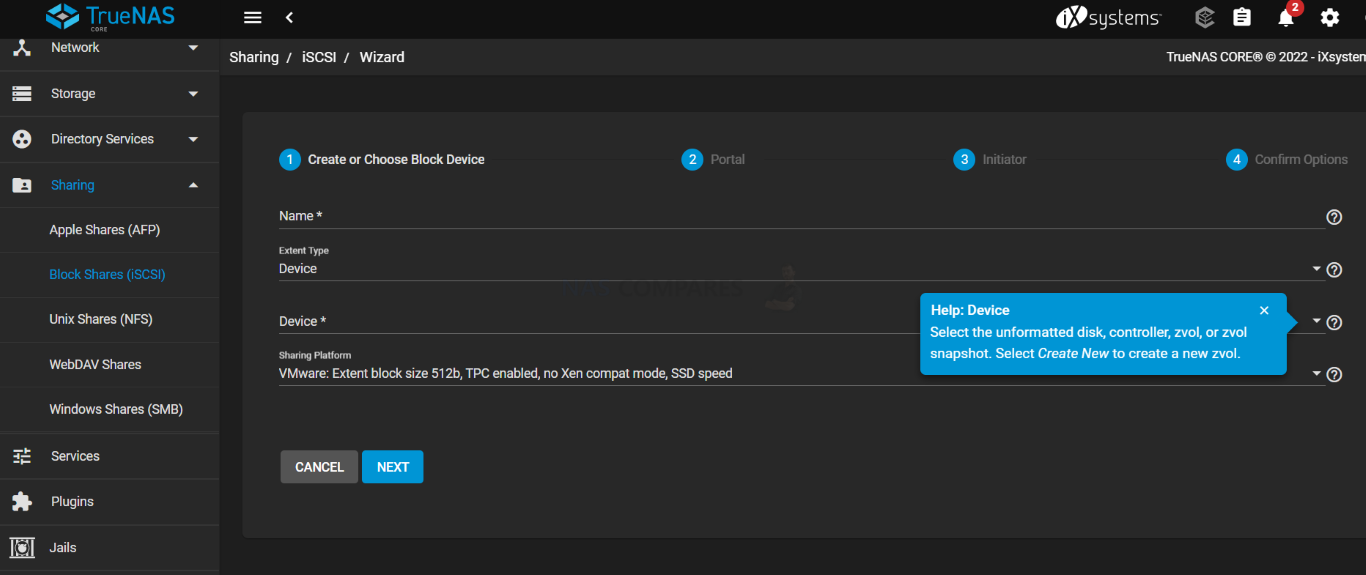
Synology DO support a variety of services and protocols and many are available to be viewed, configured and actioned in the control panel>file services, however, they do prioritize iSCSI mounting services for those that want to bolt-on areas of Synology services remotely to an existing network more than most other services in DSM, with the dedicated SAN manager. From here you can create some quite detailed targets and LUNS for use in everything from bog-standard 100M networks all the way up to 10/25/40G Fibre Channel networks.
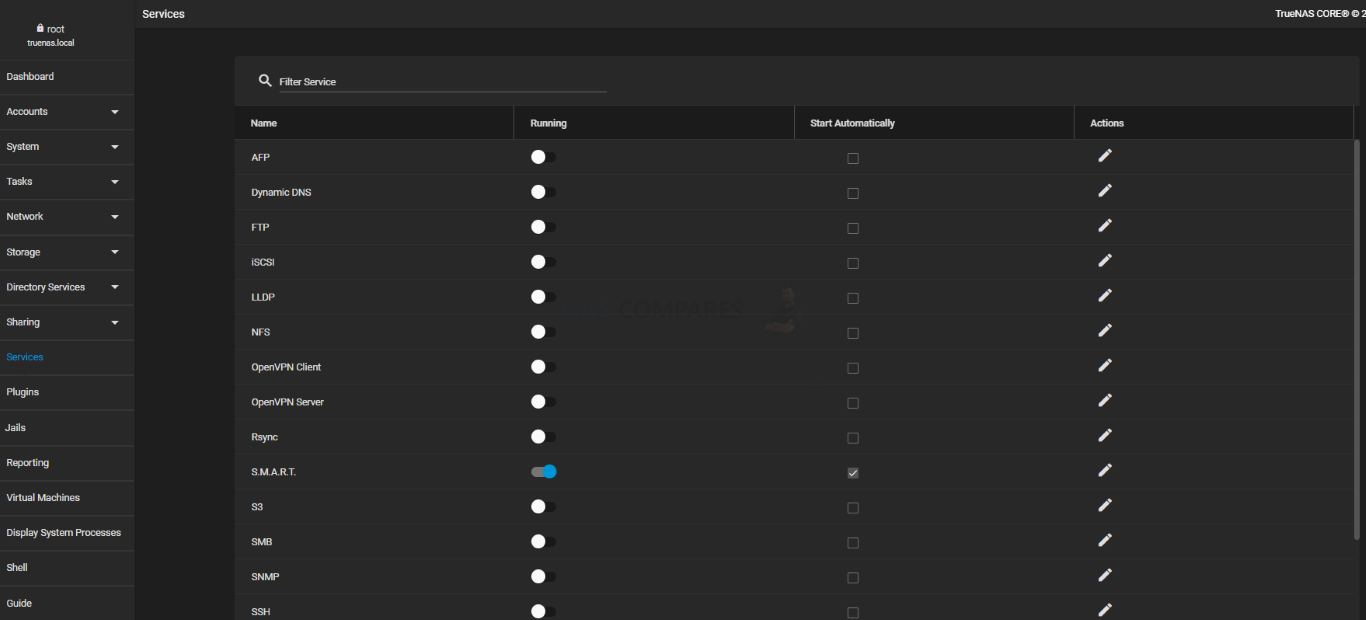
Now, I should stress, that doesn’t; mean that TrueNAS have the means to allow users to access their data natively. The range of supported services and sharing tools built into TrueNAS is pretty vast and allows very customizable, secure and unique access remotely. Rather than attempting to emulate those SaaS and PaaS 3rd party providers, TrueNAS has instead chosen to concentrate SQUARELY on the storage element of the operation and then supporting as many 3rd party tools and services it can. In this, they achieve hugely and you cannot fault the storage management of TrueNAS and how it can adapt the storage pools, shares and access to best fit a particular connecting service. That means that if you were looking at a NAS server and were already heavily invested/comfortable with your existing 3rd party file/folder manage meant software, you will likely see a greater degree of flexibility and customization in the more open-source TrueNAS storage than Synology’s DSM platform that seems too much rather prioritize it’s own services (but still supporting 3rd party tools, in an arguably more uniform way).
Synology DSM 7 vs TrueNAS Core – First Party Tools and Add ons
Now, if you read through my details on file/folder management on TrueNAS and Synology DSM, then you might have a good idea how this is going to go down when comparing these two platforms. However, it’s not quite as cut-and-dry as it might seem. Unsurprisingly, the range of first-party tools and applications is greater on the Synology DSM platform and graduating slightly from the SaaS apps mentioned earlier, Synology also offers a range of business and enterprise-class tools for backups, hybrid cloud synchronization and management tools for a wider array of systems in multiple locations in their CMS services. Now, TrueNAS supplies a lot of the wider area, multi-site services in their TrueNAS Command and TrueNAS Enterprise services (subscription/premium based) but regardless of all this, the range of applications in the 1st and 3rd party support are overall still larger on the Synology DSM NAS platform, with a wide array of applications immediately available and signed/trusted by the brand in the app center.
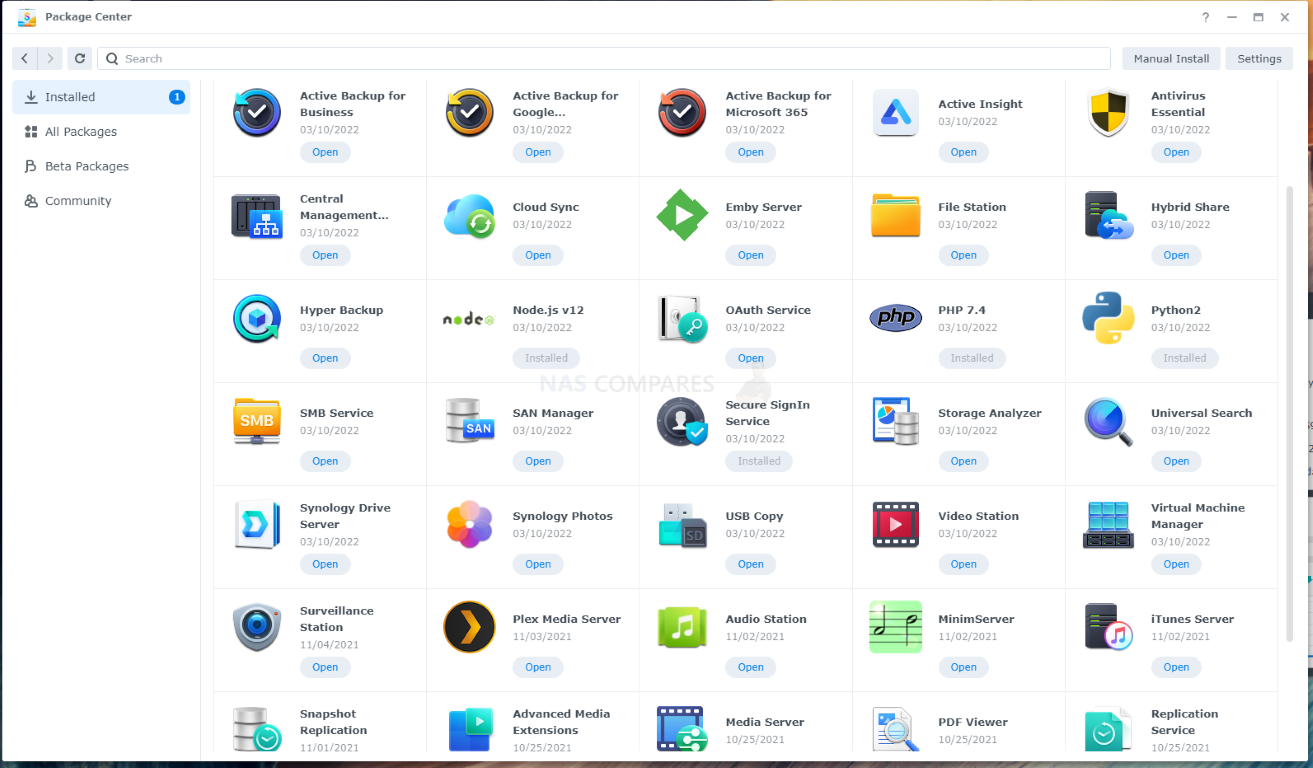
TrueNAS Core (indeed, the bulk of the TrueNAS platforms really) are much more community contributed and that results in far fewer first-party premium applications being available (with many elements that Synology offers as standalone applications being rolled into the general services of TrueNAS). Nevertheless, TrueNAS does arrive with a large range of third party applications available in the add-on center that are pre-configured for faster deployment in the TrueNAS environment. However, many TrueNAS/FreeNAS purest will choose to go full custom and homebrew and TrueNAS has tremendous flexibility in this direction. Allowing you to create custom containers (know as JAILS) that you can install community apps safely and then run very, very bespoke applications and services on your TrueNAS remotely.
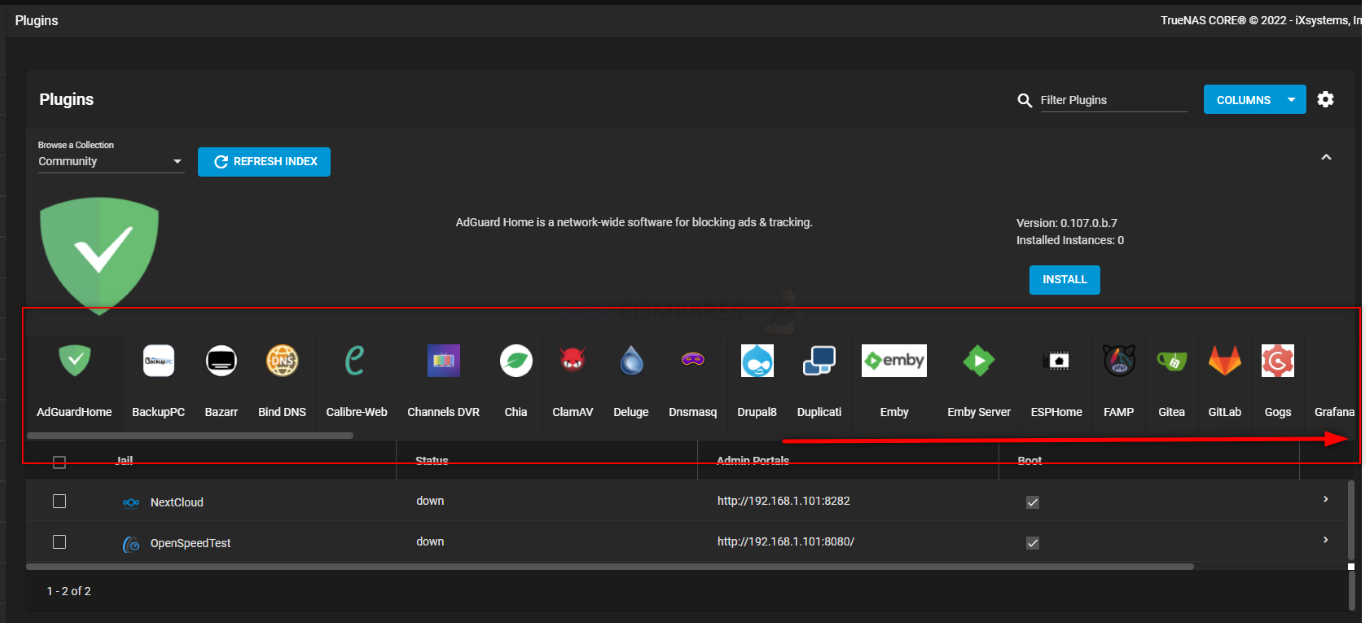
Now, as proprietary, closed and (dare I say it) stuffy as Synology is, it is also worth mentioning that there actually is a surprisingly active homebrew scene on the DSM platform that, although Synology does not really support formally, do not detur. This community comprises of two main areas, the GitHub modifying crowd who will create custom tools (typically modified from existing Linux or windows applications/tools) and then modify them into Synology deployable .spk installation files or SSH command groups. The other marginally more accessible group (at least to the average user) is the Synocommunity app repository which is far more comparable to the office app center in appearance and installation. As mentioned, although Synology does not really support this, they also do not really stop users from pursuing this, adding an option in the settings menu that allows access to unsupported apps, uncertified applications and adding third party application repositories.
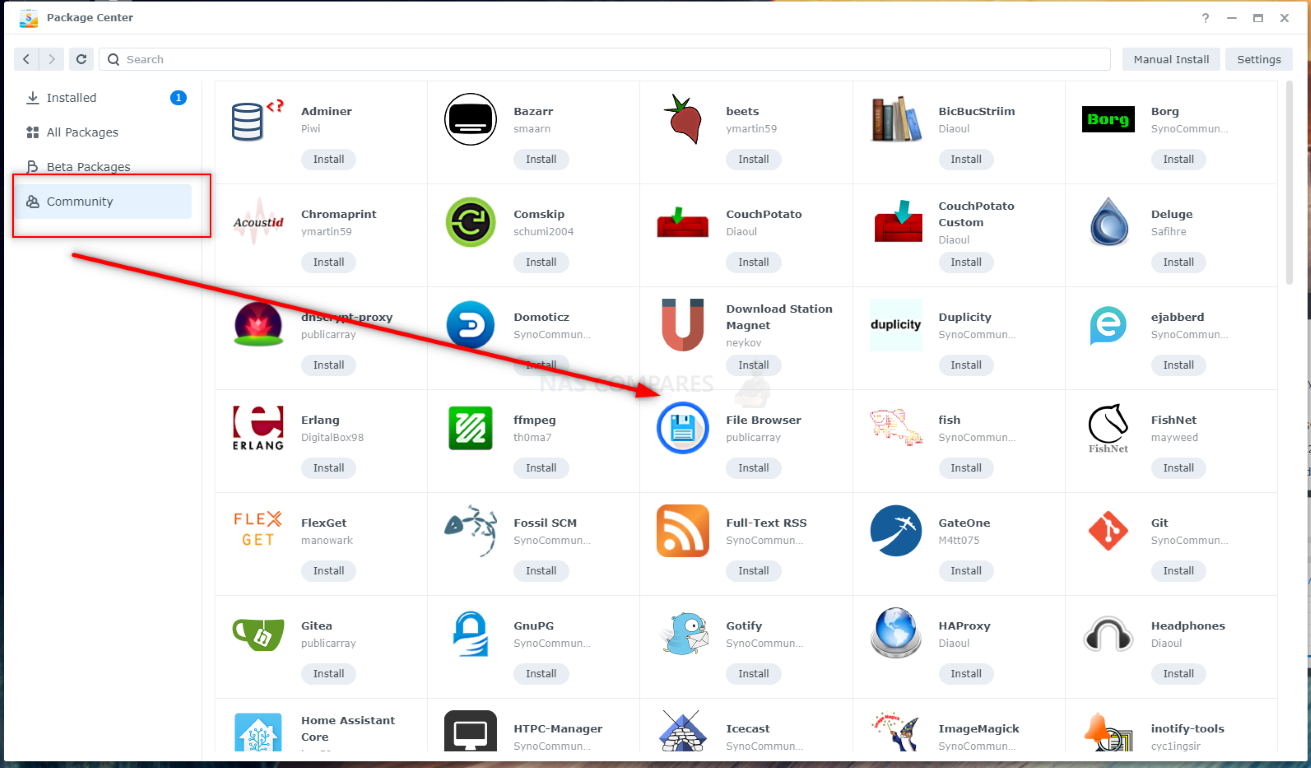
As mentioned, unlike the wider design of TrueNAS to make itself easier to be accessed by existing 3rd party network applications and services, Synology DSM focused ALOT more on those first-party applications and provides a wide variety of tools that are genuinely stand out – not just good as they are, but they really do rival enterprise and premium business tool. A couple of big examples of that are Synology Surveillance Station and Synology Active Backup. The Surveillance Station application is a web browser (and desktop/mobile client) supported video surveillance platform that allows you to add multiple cameras to your network environment and create a hugely customizable and secure surveillance environment. With the support of thousands of IP cameras that you can pick up for as little as $30 all the way up to enterprise AXIS cameras, the platform supports a vast variety of features. These include; Pan tilt Zoom control, Watermarking, Privacy masks, eMaps, Browser control/views, simultaneous archive+livefeed views, IP speaker control, intelligent recording patterns and more. It is a genuinely enterprise platform for your security, just do remember that the bulk of Synology NAS hardware only arrives with support of 2 cameras by default and adding more cameras costs an extra $30-50 (prices vary based on bulk packs) per camera. Although TrueNAS supports numerous surveillance platforms already (with at least one supported as an app in the add-on center and others able to point their storage recordings at the TrueNAS system) these will likely have their own subscription payments attached.
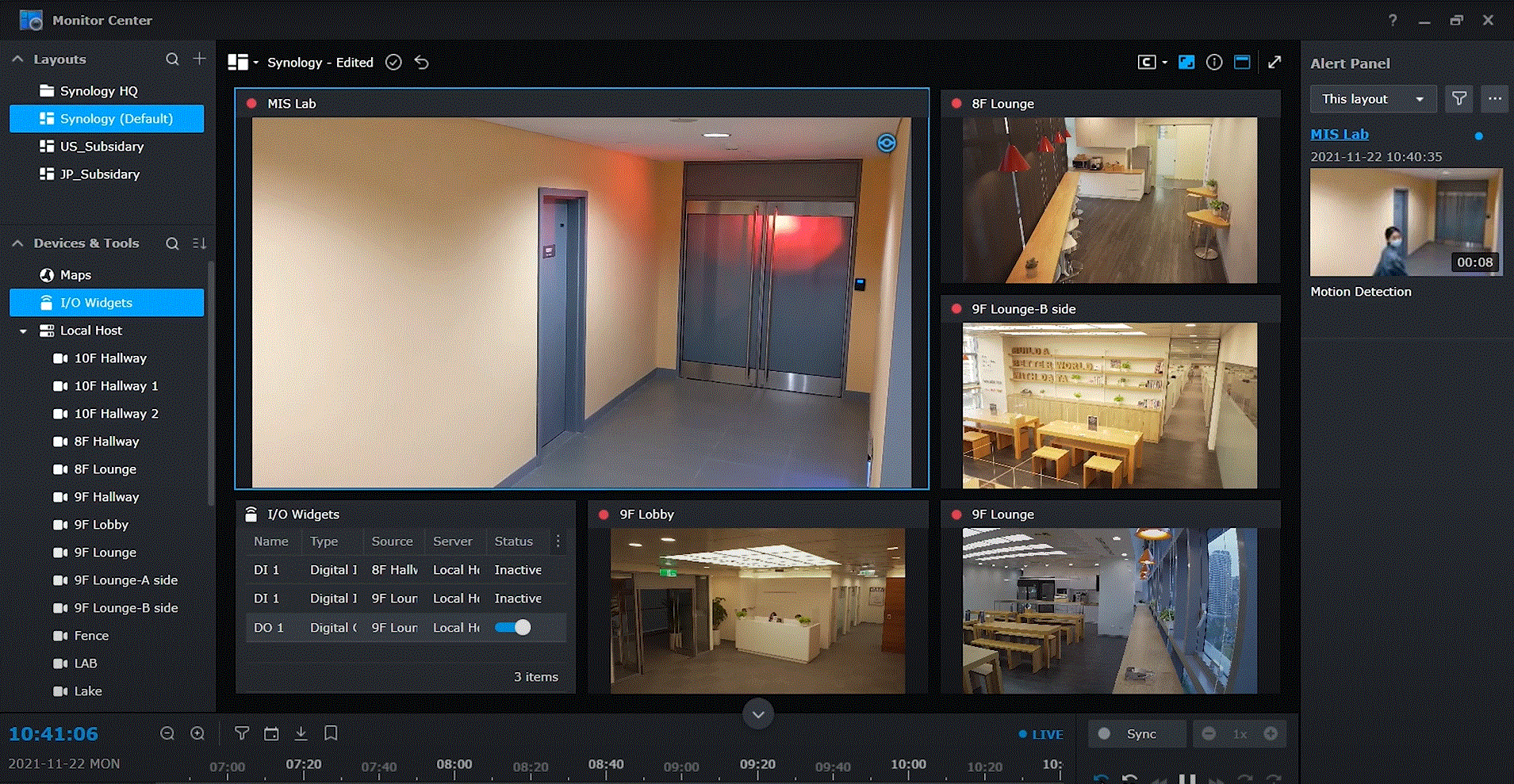
The other big, big enterprise application that the Synology DSM platform includes is Active Backup Suite, a single portal, multi-client backup management tool. Now, this isn’t to be confused with Synology Hyper Backup (with does manage backups, but in a far lower level and client way), which is designed to backup much more high profile storage and devices. These can range from local PCs and clients tools, to virtual machine hypervisors such as VMware and Hyper V and SaaS cloud services in Office365 and Google Workspace. This is provided licence free and is comparable (favourably too) against other enterprise-grade hybrid backup tools for businesses that cost thousands of pounds a year. It is quite a resource-hungry tool and I would not really recommend it for a more affordable Synology NAS, but it’s a real deal-breaker. Once again, there IS support of third party applications that provide these services on the TrueNAS app center, but they almost certainly have their own price plans attached.
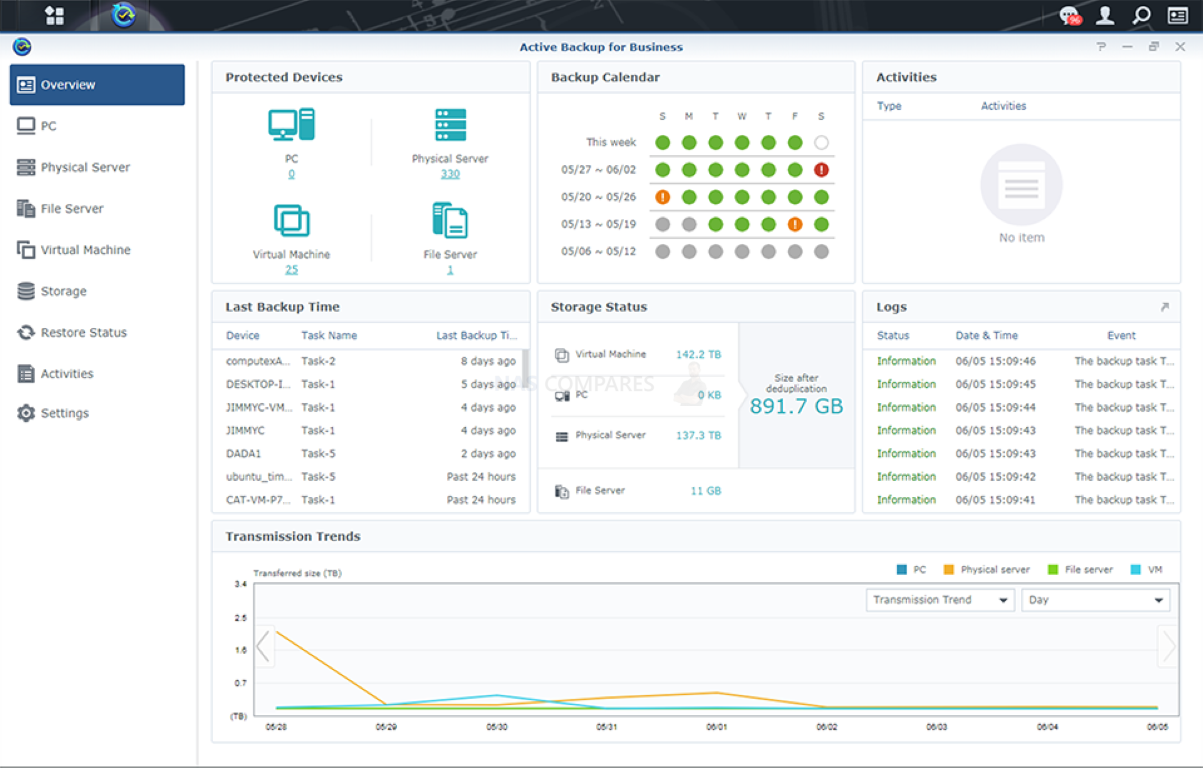
Now, this has all been rather one-sided up to this point and it makes it sound as if TrueNAS does not have any applications. It really, really does, but they typically fall into those two categories of ‘3rd party supported’ or ‘integrated into TrueNAS natively’. TrueNAS takes the arguable mature decision to ashew the idea of 1st party applications in favour of these being existing services from within their software. Everything from iSCSI support to the individual file-sharing protocols being default on/off settings on day 1, TrueNAS has a lot of native software services built-in from the start and they can be enabled easily. The lack of 1st party applications available for first-party hardware clients (mobile clients and desktop clients) is noticeable, but as long as you are thinking about the TrueNAS system as an additional storage system to your setup and not its own independent system, then you will likely never even notice.
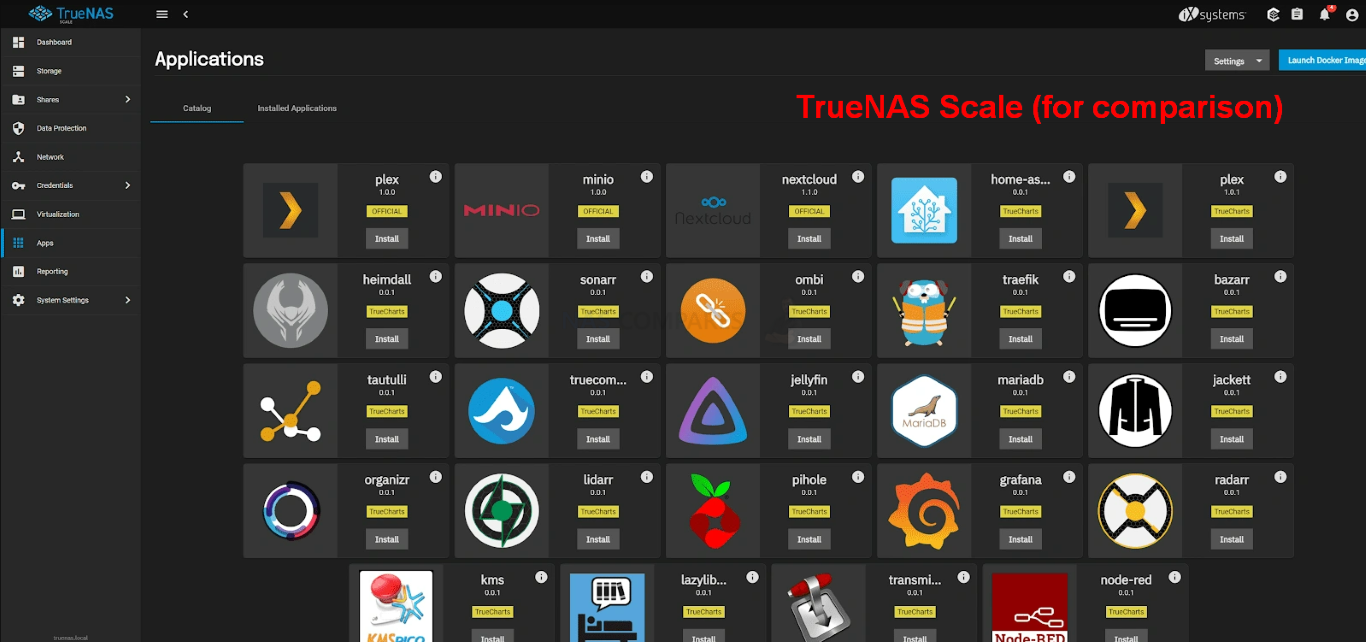
One big factor for more business geared users who are considering TrueNAS is how each NAS system approaches the subject of virtual machine deployment. The NAS hardware certainly serves as a base to host multiple VMs, but the need for a dedicated and competent hypervisor to host and mouth them all will make all the difference. In the case of TrueNAS, virtual machine creation and deployment is noticeably easier to do than on the face of it and straight away from the initial GUI, you can create a flexible virtual machine hardware system, customizable from the ground up.
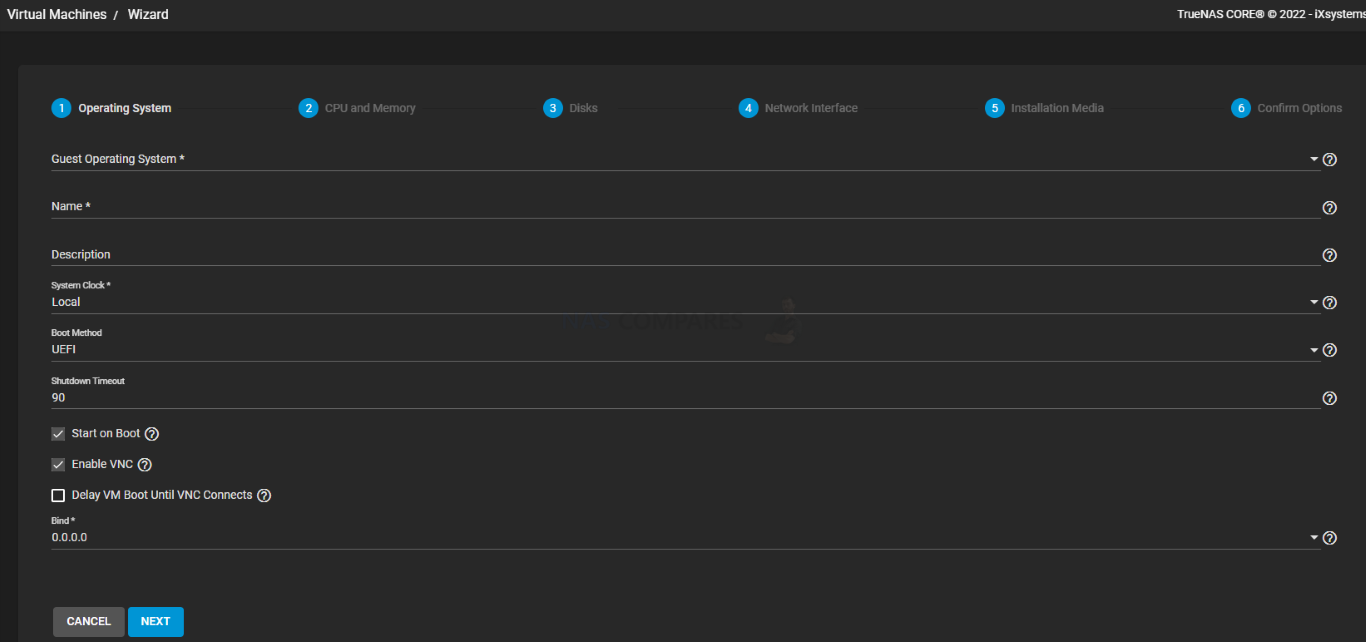
Now, Synology also supports the ability to create a virtual machine, but they do so by installing the Synology Virtual machine manager software. The Synology VMM platform is a professional grade virtual machine platform that is included with your Synology NAS hardware purchase in DSM7 and allows you to create virtual machines quickly and easily. This hypervisor platform genuinely can rival the likes of VMware in its ease of use and even includes the means to convert/adapt existing Virtual machine images from other 3rd platforms into its own more compatible structure within a few clicks. Overall, the virtual machine support on DSM is a little broader than TrueNAS, but TrueNAS core is significantly more customizable in its hardware variables, as well as allowing more options during the creation of a new virtual machine environment on day 1.
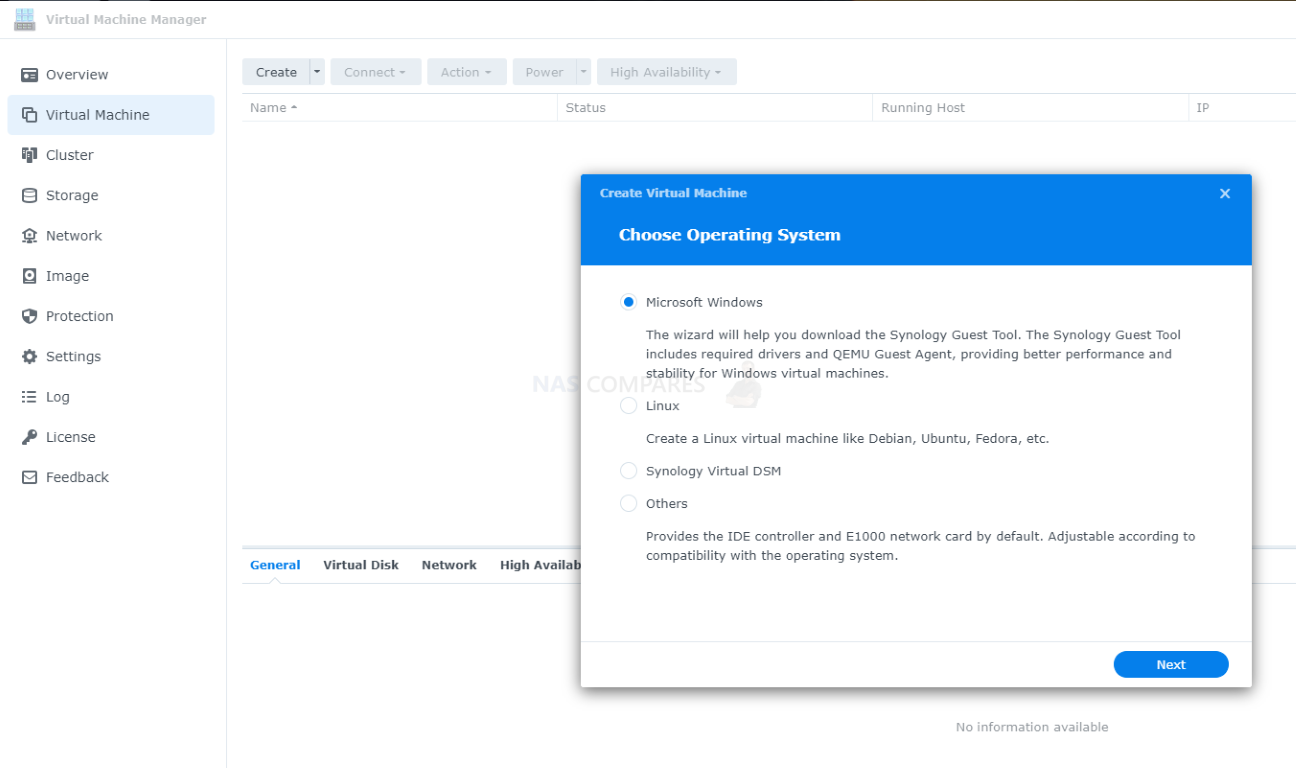
When it comes to optional upgrades and add-ons to the NAS system, you cannot really fault the options that Synology’s DSM platform offers. Yes, Synology DSM is a paid platform vs the free-to-download open-source structure of TrueNAS, but even then, you can see where a lot of that money has been reinvested into DSM. Synology is remarkably keen to replace the core 3rd party applications that most users feature in their network environment, creating a closed Ecosystem, etc that provides all those applications under a first-party banner. The TrueNAS platform on the other hand provides virtual machine deployment options in its primary system software and is even the tiniest pinch more customizable in how you can build your Virtual Machine environment. This is also improved on a hardware level when you bear in mind that TrueNAS is hugely free in its hardware build and it allows end-users to build a powerful computer base for TrueNAS to then divide into different VMs as needed. Synology has some relatively powerful server-grade hardware at their enterprise level, as well as active-active servers with dual CPU setups that build with Intel Xeon Silver processors, but the hardware is still a fixed specification and aside from improving memory modules and adding caching, the scalability to the hardware on the NAS for multiple VM deployments will always be greater on TrueNAS in the long run. Ultimately, Synology still largely wins the battle of 1st party applications, add-ons and 3rd party hardware with their recent hardware, but the margin between the TrueNAS configuration and flexibility vs the Synology fixed but straightforward deployment is certainly worthy of note.
Synology DSM 7 vs TrueNAS Core – Security
As you might expect from software that has been developed at a time when data security concerns have never been higher, both Synology DSM and TrueNAS Core are among the most secure platforms that you can store your personal or commercial data on. As bold a claim as that sounds, these two NAS platforms have been the least affected by ransomware, malware and exploited vulnerabilities over the years, with the only notable event being back in 2014 with Synolocker. Indeed, both brands have their very own Security Advisory pages that publish any found vulnerabilities and gives status updates on how they are being dealt with, with TrueNAS HERE and Synology HERE. All that said, both platforms are architecturally very different in how communication between services, tools and applications can communicate inside the system, as well as how security management is presented to the end-user. Moreso than arranging your storage, the Security settings and recommended setup for an individual user is going to be of huge concern on day one. Of the two brands, unsurprisingly, Synology has presented this in a much more user-friendly fashion, with the inclusion of a security advisory panel that can be run any time or on a schedule. This tool checks a wide variety of settings that can range from password strength, to active users, to ports, app controls, redundancy, backups and more. It is a really useful tool to those that do not fully understand the intricacies of keeping their system secure on a tech level and is something that really surprises me is absent on TrueNAS.
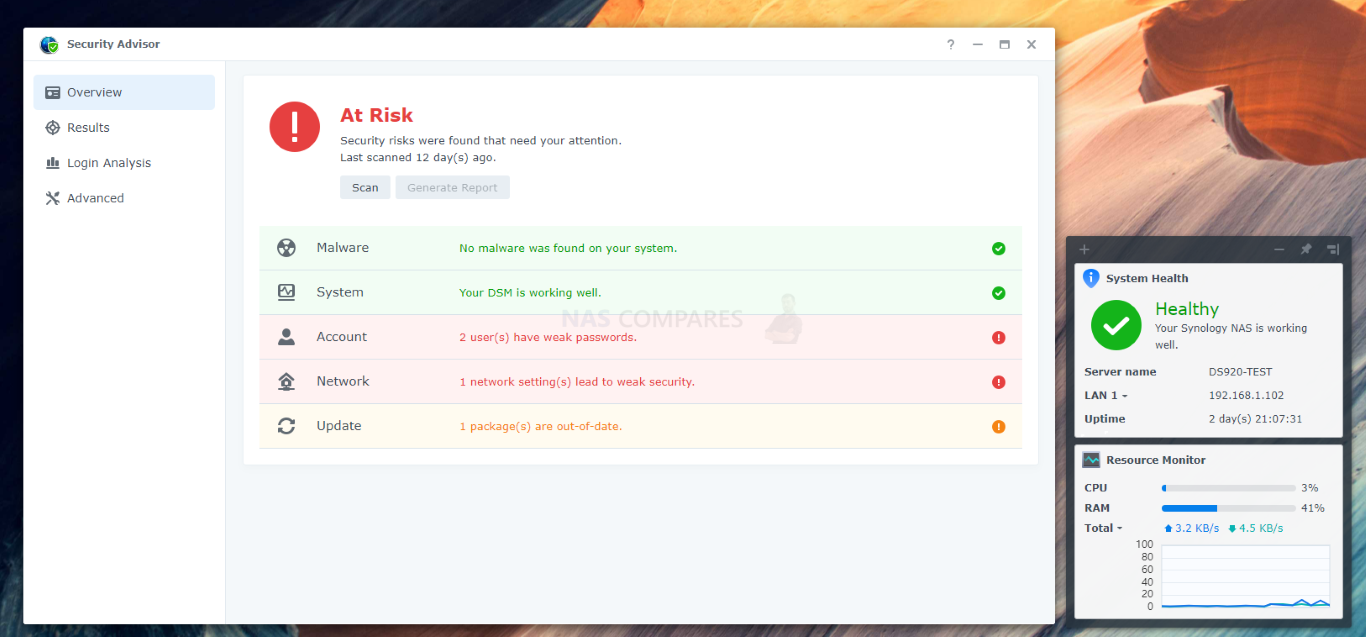
The TrueNAS platform on the other hand chooses the usual angle of providing a huge amount of control via a single screen (which to be fair features a lot of tips/? bubbles for guidance at times) that allows the users to choose how and what they want to allow to communicate. One useful thing to note is that by default, ALL of these communication settings and system tools that can affect your security are OFF by default. This isn’t particularly unusual (as many of these would be off on most NAS platforms), but on other NAS software such as Synology DSM or QNAP QTS, these settings and services are spread across multiple areas of the GUI control panel ad file services. Having them ALL listing in a single window so you can change settings much quicker makes a lot of sense and in terms of shutting ALL the doors in the event of a network security concern, this can save valuable time.

And whilst we are on the subject of being aware of security concerns (as well as when your system is exhibiting unusual behaviour) TrueNAS definitely provides a much better range of customizations on security alerts and notification than Synology DSM. That isn’t to say that Synology DSM doesn’t have notifications, it has lots of settings and they are be scaled as ‘light’, ‘medium’ ‘high’ and ‘custom’ for your convenience. But TrueNAS has an enormous ranging list of notification options that affect some remarkably detailed areas of system/network behaviour. They will take quite a long time to scroll and adjust if you want a truly bespoke notifications and alerts setup, but it simply has more variables than the default Synology DSM 7 NAS package. Now I say ‘default package’ because once again, Synology does have the subscription-based service Active Insight that is considerably better, can be broken down into excruciating precise detail and allows you to create custom reports that are delivered in a much more ‘human’ email format to the managers concerned. It is just a shame that this service is an additional subscription service and not one that is included with the system.
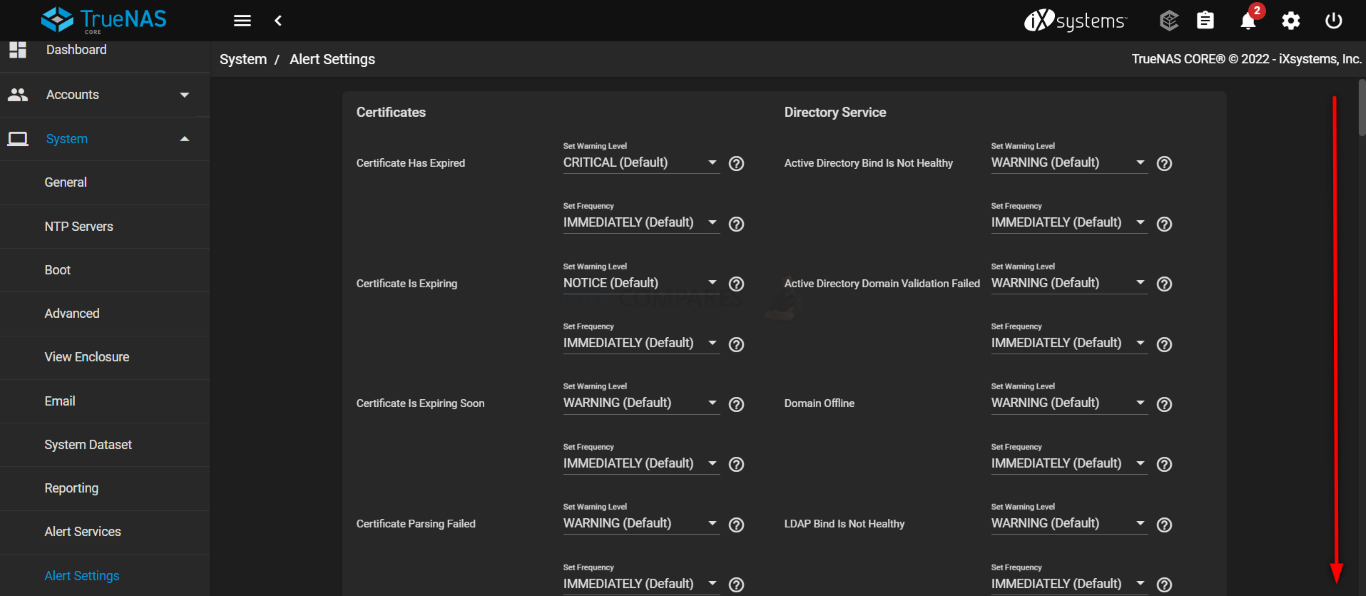
Then you have the often applauded TrueNAS Jails system that, although similar to Linux containers in the description, are much more secure and sophisticated. TrueNAS jails are contained instances of FreeBSD and they can be used to create standalone services and environments, with fully customizable levels of access to the rest of the system, your storage and users. By default, JAILS are almost completed separate from the rest of the system and in order to allow select users or services to interact with the JAIL (in either direction) is something the user needs to implement themselves which means that the chances of accidentally making an unsecured JAIL are reduced. Now, Synology DSM allows container creation for those homebrew/custom services to be added, as well as handling some 3rd party tools in its app center such as Plex Media Server (which hinges quite a lot of remote access port opening and access to your file/folder structure more than most) very securely. However, the services and tools that you install in the Synology NAS are tougher to configure on a detailed level (unless you use Putty and have some SSH knowledge, and even then it’s not guaranteed) and this makes the JAILS system of TrueNAS come out of it better.
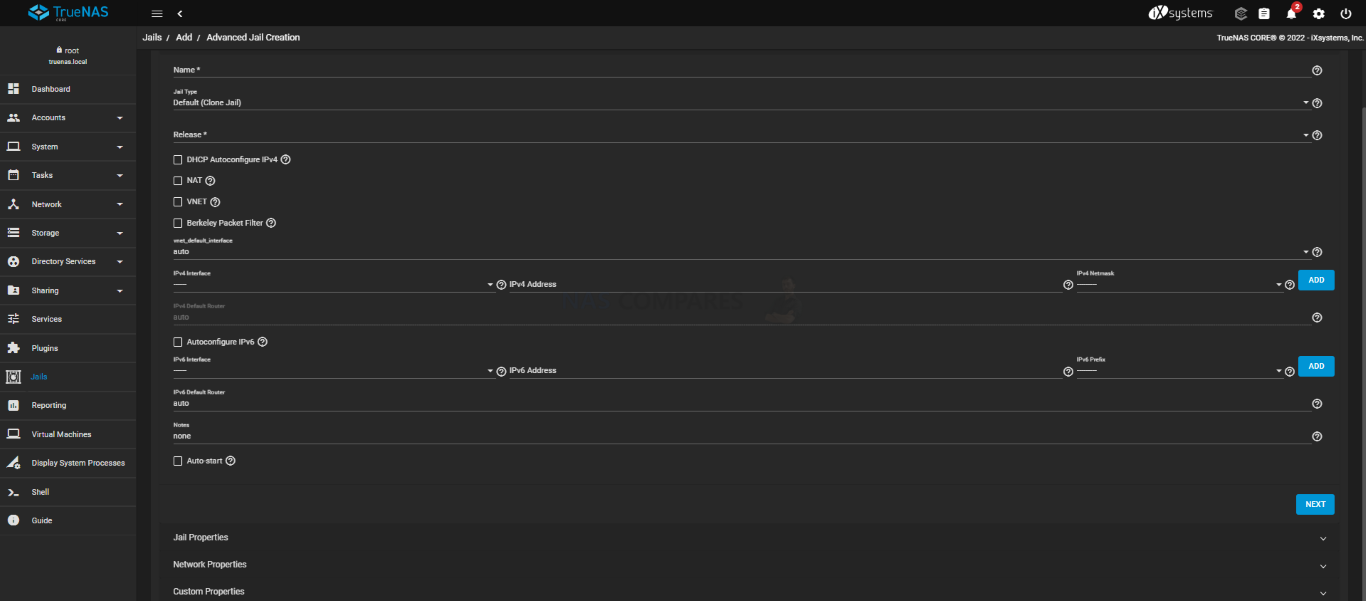
Then you have the subject of Encryption. For those that are not aware, when it comes to encryption on a network-attached storage server, that can mean one of two areas. There is an encrypted connection that can be facilitated by an SSL certificate (both platforms support a wide range of paid/free SSL certificate options that can be applied to the system easily) OR much more often it can be referring to the data on your NAS living in a container that has encrypted lock and key architecture. This means that during the creation of your storage, you set the system to encrypt all data that is written to the disks and it can be mounted/locked with the use of an encrypted key or a downloaded digital key that was generated during setup. Now, as mentioned, both Synology NAS DSM and TrueNAS core support encryption, as well as supporting self-encrypted drives (SEDs). However, you can encrypt things to a wider degree in TrueNAS (Pools, zVols, zDevs, etc) than you can on the Synology DSM platform. Additionally, TrueNAS supports a wider range of encryption protocols and also supports an interesting ‘passphrase’ system that allows a user to lock/unlock their encrypted storage container quickly without entering a long key or keeping a digital encryption key on a local system.
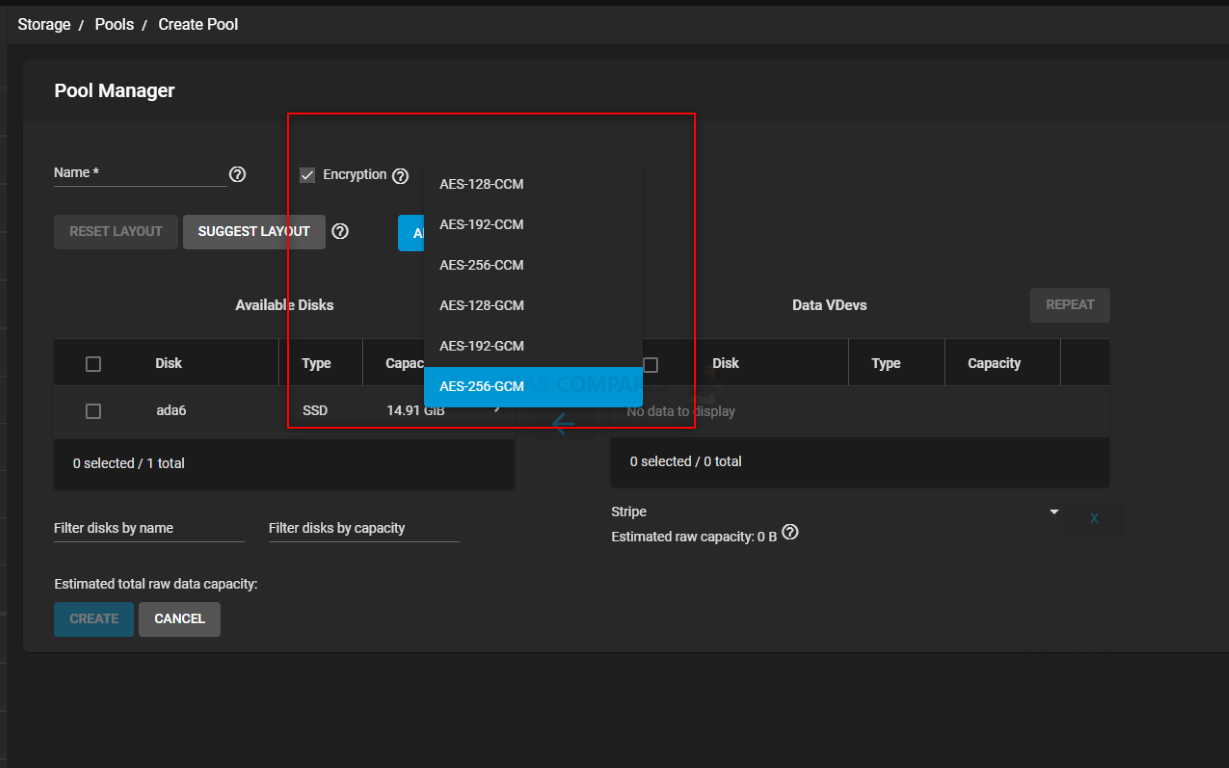
Then there is the subject of security on the NAS in conjunction with connected and permitted users. We have covered that user and group account creation on Synology DSM and TrueNAS Core are quite comprehensive, but what about 2-Step authentication (also known as 2FA)? Two-step verification is the means to add an additional layer of user login verification by asking the user to provide a periodically generated code from an existing authentication tool (such as Google Authenticator on a mobile phone) that, although uses a 1 step setup algorithm, is randomly generated frequently. Now, Synology DSM and TrueNAS Core both provide this, but each has its own extra little spin on it in terms of how it is deployed. In the case of Synology, you can set up 2-step verification easily and on all associated system accounts, with numerous 3rd arty authenticator tools supported.
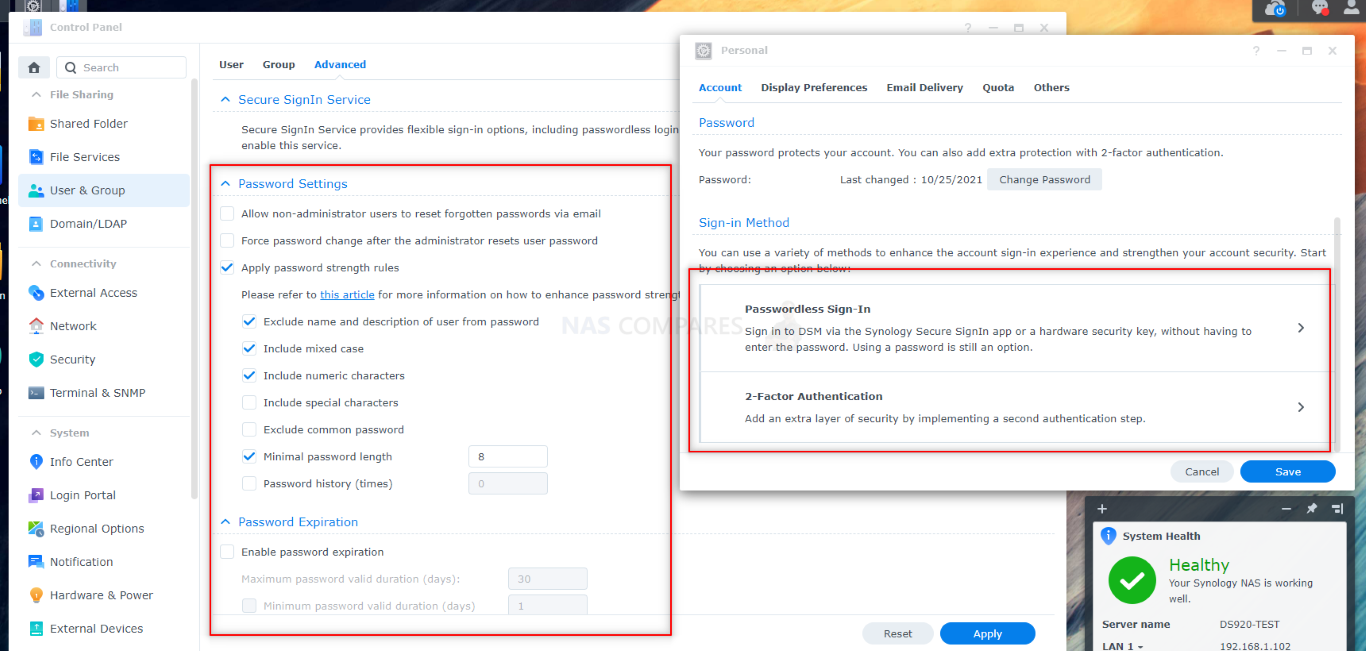
However, Synology go one step further and also provide their own authenticator tool for iOS and Android that allows you to keep your security in-house, as well as a few configuration options rolled in too. For companies that supply handsets to their staff, this allows them to keep continued use of Synology NAS storage to remain in a single company ecosystem. This also allows support of backing up the OTP profiles that you have created for logging into the NAS to your Synology Account. This resolves the often overlooked issue of if 1) you change phone devices and did not export your existing associated logins and more importantly 2) if you mobile phone unexpectedly fails/is lost, then you can restore the connected OTP login details very easily to a new handset.

Now Although TrueNAS does not have its own first-party authenticator application for iOS/Android (instead supporting the popular 3rd party applications out there) what TrueNAS DOES offer is an impressive range of setup customization options in its 2FA settings menu, allowing you to change the length of the code, the period of time between each refresh (VERY useful for those with accessibility difficulties and take longer to enter the access codes) and allows you to directly apply this customized code generation to SSH connections too. Although most users will likely stick with the default settings, I can definitely see particularly security-conscious users who need to distribute system access pretty widely liking this degree of flexibility.

Talking of wider access to the system, I do think it is also worth highlighting that TrueNAS is almost completely API designed. So, why is that important and related to security? Well, it is not always just going to be human users and installed applications that you might wish to access your NAS data. Alot of users are using the contents of a NAS to provide information to a remote services connection (such as web servers, external software CRM and CMS tools and security systems) and instead of supplying these services with powerful login credentials to the system (which can be a headache down the line if those account details, used in numerous smaller services, are changed for security reasons to the wider NAS system), they generate an API key to bridge the two and given that TrueNAS is massively API ready, it means that you can be quite flexible and customizable in the areas you connect. The Synology platform supports several API elements, but not to the same degree across the board as TrueNAS.

Overall, both the Synology DSM and TrueNAS Core platforms are very secure and although they take different approaches at times, they both seemingly come around to the same conclusion. On points, I would say that the TrueNAS system has the larger potential to be customized in its security setup, but (as usual) requires you to spend a greater deal of time to set it all up to your tastes/requirements. The Synology NAS DSM 7 platform on the other hand is considerably more user friendly (again, I know, I am a broken record) with options such as the security advisor to scan/change your system in line with its recommendations, as well as first-party tools in Active Insight and Secure Sign-in allowing you a much more brand supported experience. You can set up the security settings on a Synology NAS considerably faster than on a TrueNAS, but if you have a very particular idea of your network storage security setup, the TrueNAS platform provides a wider degree of flexibility there.
Synology DSM 7 vs TrueNAS Core – Conclusion and Verdict

It is so easy to just look at the TrueNAS option as the free but complex choice and the Synology DSM option as the easy but expensive one, BUT the truth is a little more complex than that. For a start, the wide variety of customization and flexibility that is inherent to TrueNAS is something that I genuinely think only higher-end business users are going to be able to fully realise. Home users who are building their own NAS from scratch and opt for TrueNAS for the software will definitely enjoy customizing their solution to their needs/network-environment, but the most long term customizations, reports and adaptive protocols of TrueNAS are much better suited to a business that needs to change as business/staff/data grows. Ironically though, those users are going to be far more attracted to a ‘turnkey’ solution (i.e a NAS solution that is pretty much good to go, right out the box) and will pay for the privilege (i.e time is money). This is where Synology steps in quite confidently, as they know they are incredibly business appealing, with a massive range of first-party apps to migrate away from Google/Microsoft services, as well as management and security tools that are largely unparallel elsewhere in the industry. TrueNAS is still a viable option for businesses that desire an instantly deployable solution and business class support with the official TrueNAS hardware provider iXsystems providing pre-populated and customizable solutions, as well as tiered support subscriptions – but this only truly appeals to users who truly understand what FreeBSD and ZFS can provide that EXT4 and BTRFS cannot.

The Synology DSM platform is incredibly impressive and available in systems (as in included with the hardware as a single purchase) for as little as £120 (such as the DS120j) and scales up rapidly in price and power. Users who have little-to-no technical knowledge, do not have time to learn a new kind of technology and/or want to migrate away from cloud and SaaS services to a whole contained ecosystem without subscription costs, should opt for Synology NAS and DSM 7. It has a few subscription/license purchases on a few services, but is still largely a one-off purchase for the most part and the majority of Synology NAS users never buy an extra or a subscription. Alternatively, if you are someone who has the time and enthusiasm, already has the technical skills under their belt, has very specific storage and network requirements and/or are looking at a solution that they plan on upgrading and improving in the years that follow, then TrueNAS Core (and indeed TrueNAS Scale with Linux for that matter) is going to be a much better choice. What it lacks vs Synology DSM in 1st party applications and ease of use, it makes up for in a truly unbeatable range of customization and configuration choices that are unavailable elsewhere. Plus, ZFSis always going to be at the top of many pro-storage user lists – just remember that TrueNAS (unless you opt for an iXsystem) is Free, but the hardware and time you will spend deploying it was where it will cost you.
 |
 |
|
|
📧 SUBSCRIBE TO OUR NEWSLETTER 🔔
🔒 Join Inner Circle
Get an alert every time something gets added to this specific article!
This description contains links to Amazon. These links will take you to some of the products mentioned in today's content. As an Amazon Associate, I earn from qualifying purchases. Visit the NASCompares Deal Finder to find the best place to buy this device in your region, based on Service, Support and Reputation - Just Search for your NAS Drive in the Box Below
Need Advice on Data Storage from an Expert?
Finally, for free advice about your setup, just leave a message in the comments below here at NASCompares.com and we will get back to you. Need Help?
Where possible (and where appropriate) please provide as much information about your requirements, as then I can arrange the best answer and solution to your needs. Do not worry about your e-mail address being required, it will NOT be used in a mailing list and will NOT be used in any way other than to respond to your enquiry.
Need Help?
Where possible (and where appropriate) please provide as much information about your requirements, as then I can arrange the best answer and solution to your needs. Do not worry about your e-mail address being required, it will NOT be used in a mailing list and will NOT be used in any way other than to respond to your enquiry.

|
 |
Beelink ME Pro NAS Revealed
Best SOLID STORAGE NAS of 2025
Should You Worry About the NanoKVM Hidden Microphone?
Best Cheap NAS of 2025
Minisforum MS-02 Ultra - WHO IS THIS FOR??? (The First 48HRs)
Why People Use TrueNAS, UnRAID and Proxmox to Turnkey NAS (Synology, QNAP, etc)
Access content via Patreon or KO-FI





Discover more from NAS Compares
Subscribe to get the latest posts sent to your email.


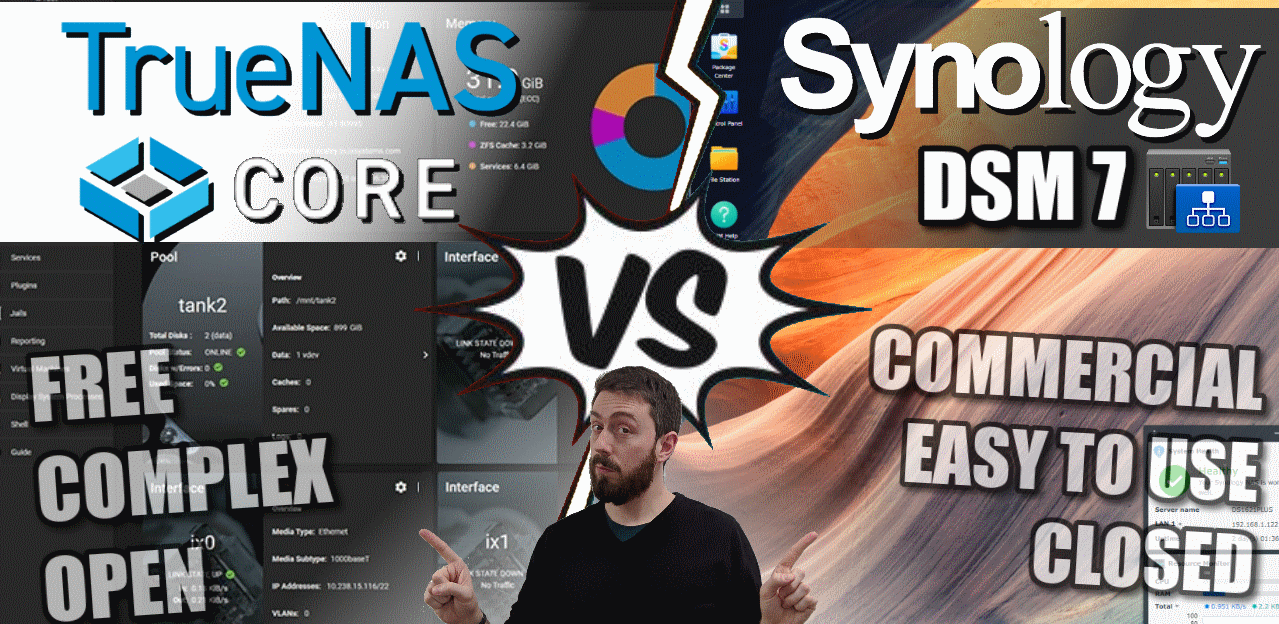



Thanks a lot for this, and a couple other, videos.
REPLY ON YOUTUBE
Thanks!
REPLY ON YOUTUBE
Customization only has sense if defaults are sensible.TrueNAS is not there, not even close
REPLY ON YOUTUBE
Would you consider doing an update comparison 2024 truenas scale vs synology software?
REPLY ON YOUTUBE
After just over a year of using Truenas I am now going to dump that system completely, it’s unreliable they push out certain upgrades which completely breaks all the apps that you are currently using and you cannot upgrade those apps anymore so you don’t get any security fixes or any extras that are being upgraded the example was upgrading to next cloud 27 that required a complete change in the system which I couldn’t implement because the system itself is just completely broken it cuts to the point where you’ve got to basically back up all your data then destroy the whole system install these upgrades alleged upgrades and then re-import all your data back I mean what the fuck are they thinking? Put out a system and then put out modification that breaks valuable data storage that the whole point of data storage is that you’re trying to protect your data not fucking destroy it, As such I would never recommend true scale or any of Truenas systems because they’re just inherently unreliable badly maintained they push out updates without thinking about how it might affect their consumers and they’re just not a very good company to be quite honest they want to make out that they’re really helpful and that they’re really useful but if you actually go to their forum pages most of them are full of gibberish the help pages are pretty un useless and obviously this whoever does actually design in the system is smoking far too much dope. Also the completely unfriendly user permission system is a mess as well I mean I don’t even know what it’s been designed that way really there’s so many other variables out there that use different systems and they have able to manage their systems correctly without having all this absolute gibberish everywhere. Basically true mass has been designed by a bunch of stoners who spent too much time at university and not enough time in the real world actually using the systems that they’re designing. it appears to me that this whole system has been designed because they want you to employ them to fix it they pretend that the system is designed for anybody to use but the fact of the matter is it isn’t designed for anyone to use it’s like Apple where they only do the repair themselves and for the most part of the system is probably like that for 80 to 90% of the people that use it will not be able to repair it in the event of a Breakdown they will have to troll the forums and do everything just like it used to be with another particular server that I’m not gonna mention And it just smacks of windows to be quite honest pages and pages and pages of useless information that doesn’t really help anyone at all. The fact of the matter is if you want a decent system the better off just installing synology using the project that’s up on GitHub and then you won’t have any of this crap to deal with that this company is doing
REPLY ON YOUTUBE
Why don’t people talk about RAID 10? I was told that was better than a RAID 5/6 setup?
REPLY ON YOUTUBE
No Raid 1 is not 2 drives cloning each other it means one drive is cloned to all other drives. It depends on how save you want to be. You can also clone this first drive to 3 others in a four bay nas.
REPLY ON YOUTUBE
Finaly a good explaination of RAID. I already understood SHR, but not the blueprintstory. Thank you!
REPLY ON YOUTUBE
Thanks!
REPLY ON YOUTUBE
????
REPLY ON YOUTUBE
Does truenas support auto photo backup from phones? Like synology.
REPLY ON YOUTUBE
I own two Synology NASes, they are (so far) a reliable storage and okay software experience,
I’ll be exploring TrueNAS Scale from now on, as it seems to be much more capable thanks to more powerful hardware support, and with Docker + Kubernetes and VM support it’ll likely become my primary application hub, keeping Synology as rcync backup mostly..
REPLY ON YOUTUBE
Does Synology have the feature to backup on NAS to another NAS and to the cloud (say Backblaze)?
REPLY ON YOUTUBE
I understand the desire for flexibility and customization of the TrueNAS, but Synology has always been rock solid in my experience and I love the simplicity.
REPLY ON YOUTUBE
Say u have 4,6,8 and,8TB. With SHR, what total size u get?
4 + 4 + 4 + 4 => 12
0 + 2 + 2 + 2 => 4
0 + 0 + 2 + 2 => 2
So I have 12 + 4 + 2 = 18TB? Am I understanding SHR correctly?
I actually have 3.6, 9.1, 10.9 and 10.9TB and now I see 18.2TB. Why not 23.6TB?
REPLY ON YOUTUBE
Excellent Video.
But you have missed certain parts of Truenas.
1. With Truenas, even if your system bricks, you can still mount the zfs pool on any BSD / Linux System [ Especially motherboard failure ]
2. You can expose shares as NFS as well CIFS simultaneously [ Not advisable though ]
3. Snapshot replication in encrypted form over wan is very much a use case. [ We do this all the time ]
4. You can install Wire guard.
5. You can excellent LSI HBA’s to extend number of drives.
6. Boot Time is much lower in case of Truenas.
7. Mounting earlier snapshot as separate share .
8. Not tied up a particular hardware.
9. API everywhere.
10. Costly but pays every penny in long run. Its enterprise system all the way.
REPLY ON YOUTUBE
I used SHR because it’s what was recommended and I do whatever process the official people recommend because I’m good with computers but I’m not good enough to trust myself with sensitive data.
REPLY ON YOUTUBE
Who wants to take a shot with me every time he says “drives” 😀
REPLY ON YOUTUBE
Great video, just a question isn’t a microserver g8 with a xeon cpu and up to 24gb ram better than any up to date synology, I know synology has allot more software, clour, remote photo synk…. thank are good but, now they recommend disabling remote access to prevent getting hacked,
REPLY ON YOUTUBE
The benefit of Synology is that it’s a full featured operating system not just a home NAS software.
You also don’t get things like BTRFS scrub, snapshots, low power consumption, stability, consistency, etc.
And if you’re using this for cloud storage and backup then mobile apps should matter to you.. which, again, Synology wins.
You pay a lot more for lesser hardware but it’s not the hardware you’re paying for.. it’s DSM.
REPLY ON YOUTUBE
What about dsm vs truenas scale?
REPLY ON YOUTUBE
Thanks
REPLY ON YOUTUBE
I think it will be more fair to compare qnap too, although recently they got qlock issue but I believe it might due for default settings not tight enough or the user lacking update the version. I used nas long years which recently eyeing to upgrade to ts-h973ax
REPLY ON YOUTUBE
❤️ Hermosa eleccion 4.FO/Elizeid de mejor
1 (elecciones ) 9.9/10 2 ( culturales ) 9.7/10
Son unos de los mejores conciertos
, no-puede-ir-pero-de-tan-solo verlos
desde pantalla,, se que estuvo
Sorprendente .
REPLY ON YOUTUBE
Hi, I run a company and I use Synology Nas to share and receive data. Each customer has their own user name and can access file station using quickconnect. This works very well but my only issue is that I need to manually access each folder to see if there has been an upload. Is it possible to get an alert when a user logs into DSM using quickconnect or a notification when there was been an upload?
Thank you
REPLY ON YOUTUBE
I use both systems, but prefer TrueNAS mostly because of ZFS. I just noticed TrueNAS Scale does not seem to have alerting yet. 🙁
REPLY ON YOUTUBE
If only Synology didn’t complicate things by locking out other branded HDDs and not supporting SHR for some of their range regardless of the performance impacts sometimes there is a use case where you need the flexibility of mixing drives. They could recommend NOT to use it in the setup with a description of why but taking that choice away is a mistake.
I am looking at buying a larger NAS at the moment and unfortunately synology is immediately disqualified from my choices due to their decision on forcing their HDDs. Why didn’t they just have the advantage of updating HDD firmware with a button push or maybe a longer warranty if using their drives as a carrot… they are forcing me to look at other options… who know maybe when I look elsewhere I will like what I find and never come back… really REALLY silly decision.
REPLY ON YOUTUBE
You did really well with this and as unbiased as you could possibly be.
My background isn’t in IT, so I initially looked at QNAP, then Synology and for my needs they weren’t sufficient in the event of multiple types of failure. I had the money and more importantly I was prepared to put in the effort for greater file integrity/safety. I didn’t find the Apple approach to data that Synology use (you can have it back, if you buy another Apple), but I appreciate that’s for ease of use.
I started by throwing an install on an Athlon CPU machine (very old) that I had knocking around and had 6 320GB drives to use as well (along with a spare SSD for the boot drive). I just played with it very casually, harshly pulling drives and seeing how easy it was to fix. Direct play Plex used only a few percent CPU usage, which impressed me – it only pushed the CPU with transcodes.
Two years on and I have an understanding of a system that I trust with my business and personal data. As so much of our lives are stored in bits and bytes, it makes sense to do what you think matters when it comes to protecting it.
Well done for this, it was really interesting to see the Synology GUI.
REPLY ON YOUTUBE
The thing that got me was the hybrid raid. Like…that’s common sense thought why wouldn’t everyone want that feature if possible.
REPLY ON YOUTUBE
???? I’m a DSM fanboy, but I need that safety net of TrueNAS available to me, if Synology changes their business model to a subscription service or pushes their hard drives more.
REPLY ON YOUTUBE
QNAP system, btw, jokes apart; really… i’ve tried synology, i’ve tried freenas, i’ve tried truenas, i’ve tried them all… in the end i always come back to qnap system, cause are the best for my needs 🙂
REPLY ON YOUTUBE
For the novice… Dsm…
For the little bit more advanced user… Truenas.
In general Truenas, because you can use your own hardware or the ix system hardware.
REPLY ON YOUTUBE
Thank you for the excellent comparison of the two. Sticking to the Synology path as my tech skills are low. Cheers
REPLY ON YOUTUBE
I’m pgrading from a DS218play to a DS920+. I have 2 8TB 5400RPM WD Red drives that are running out of room. Can I add a single 12TB 7200RPM WD Red drive or do I need to stick with 5400RPM?
REPLY ON YOUTUBE
Thank you, even watching this in 2021 still useful to me.
REPLY ON YOUTUBE
thank you so much for this guide, been searching all over to find exactly this 🙂
REPLY ON YOUTUBE
can you do it in english, or at least put subtitles ??
REPLY ON YOUTUBE
Hi I love your channel, great info! I have a question I hope you can help me with. I had a DS411 en bought a new DS920+. I transferred two HDD’s from the old to the new (SHR) and it works great. I want to use virtual machine but my structure is EXT4 and it requires BTRFS. Now my plan: I want to eject disk 2 so the systems says there is a damaged disk while booting up. Then I want to erase disk 2 and make a new volume with BTRFS. Then I want to copy al the data from disk 1 to disk 2. Then I want to erase disk 1 and make a SHR pool with disk 2. Do you think this is a good plan? Or do you think I can’t copy the data, because I don’t know for sure with SHR if it’s an exact clone or something like a blueprint. Thank you in advance for your help!
REPLY ON YOUTUBE
was always wondering about SHR technology. well explained, thank you very much!
REPLY ON YOUTUBE
Incredibly Helpful – You’re knowledge demands respect, and your delivery is easy to follow, charming thorough yet succinct. Thankyou and well done.
REPLY ON YOUTUBE